C&C related articles - 1992 -2011

New Scientist Interview
With the Kyoto Protocol on the verge of collapse, the search is on
for a formula to get us off the hook of global warming. One of the
main contenders is a proposal by a professional violinist with no
sc ientific training. Aubrey Meyer has entranced scientists and enraged
economists and many environmentalists with his idea, but it is
winning high-profile backers, such as China and the European
Parliament. He says it embraces science, logic, fairness, even art.
Could it yet save the world? Fred Pearce gets to the bottom of it.

Composer and string musician, turned award-winning environmentalist, Aubrey Meyer tells Nature Climate Change why he is campaigning for countries to adopt his 'contraction and convergence' model of global development to avoid dangerous climate change.
Fiddling with climate change
Nature Climate Change 04 December 2011

Contraction and convergence
Perhaps the boldest scheme for reducing global carbon emissions and one on the kind of scale that’s needed comes in the shape of so-called contraction and convergence. Under this proposal, there would be a period of convergence, with the world’s nations working towards a predetermined per capita carbon budget. At this point, it would be possible to begin a period of contraction, with carbon consumption being scaled back en masse. “Contraction and convergence is not only the right way to solve the problem. It is the only way,” says Aubrey Meyer, director of the Global Commons Institute and the architect of this scheme. In 2003, the secretariat of the United Nations Framework Convention on Climate Change acknowledged that its objective to stabilise the rising greenhouse gas concentration in the atmosphere inevitably requires contraction and convergence. Yet there is still no agreement on the details of how to take this plan forward. With the UNFCCC up for discussion at next month’s Conference of the Parties in Durban, South Africa, Meyer is clear about what’s needed. “There absolutely has to be a negotiation about the rate at which we converge on equal entitlements,” he says. The consequences of putting this off hardly bear thinking about. During past mass extinctions, notably in the Permian era increasing temperature triggered the massive release of carbon stored in the soil, permafrost, and forests. If we reach this tipping point and we experience so-called ‘runaway climate change’, it’s game over. Attempting to model that is like attempting to model your funeral after the event,” says Meyer. It’s ludicrous. In this brutal light, Homo sapiens starts to look like just another run-of-the-mill species, for which survival and reproduction are merely sorry steps towards ultimate extinction. I fear that the human species itself is not as highly evolved as we might wish it to be, says Adrian Lister, professor of paleontology at the Natural History Museum in London. Faced with this unsettling thought, it would be tempting to throw up our hands and retrench into our current, unsustainable ways. But this is hard to do with a conscience. As befits a product of natural selection, we humans are understandably fond of reproduction and there are few things that motivate us as much as our children do. But uniquely among evolved organisms, we are also able to predict what kind of a world we will leave them, and it doesn’t look good. “We are on a track at the moment that could give us a temperature rise of 4 or 5°C by 2060,” says Hugh Montgomery. “My younger son will be in his early 50s at that point, and that’s not a world he will survive in. Doing nothing is not an option.
Unhealthier by degrees -
More than 300 delegates from healthcare, the military, climate science, industry, business, and
politics met at a BMJ conference last week to consider the risk climate change poses to human
health.
Henry Nicholls reports for the British Medical Journal October 2011

Virtuous cycles
So five years on, where are we? The council has shown that a fair global solution to climate change, as exemplified by the Contraction and Convergence framework means that what's good for the climate is good for health. Council members have also made substantial contributions to the seminal work published by the Lancet. As well as benefitting individual health through the reduction of carbon emissions, relevant measures have considerable socio-economic benefit, and so create the virtuous cycles of promoting social, environmental and economic gain synergistically. We are working with others to quantify the health gains which such measures will produce, with the ultimate aim of producing a health 'Stern Report'. This offers a more optimistic prism through which to view climate change, as our council member Hugh Montgomery found when talking to delegates at the recent COP conference in Cancun. Raising awareness of health implications could make a difference to global negotiations so the council will try to ensure that delegates going to Durban are better informed. We will ask the nearly 6,000 supporters from 130 countries who have signed our pledge (and if you haven't signed, please do so now) to contact their negotiators.
MEDACT Communique
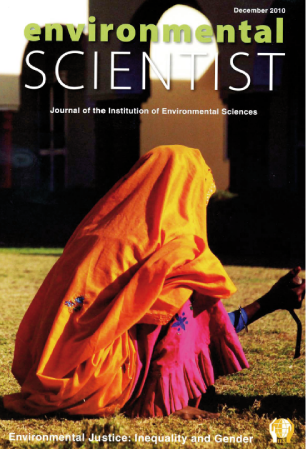
C&C_the 'numeraire': - 2011 Article_for IES Journal
Central to the protection of the economy is the necessity
of preventing dangerous rates of climate
change. To comply with the UNFCC's objectives,
GCI argued that the relevant unit of measurement
was global emissions 'entitlements' in a structure
of Contraction and Convergence, measured
in tonnes of carbon per unit time, not money. To
comply with UNFCCC goals, the unit for measuring
GHG emissions 'needs to know where it is going'.
Money cannot therefore be the unit of measurement
because it cannot do this, beyond being
linked to an ex ponentially and indefinitely rising
curve of 'economic growth' with 'expansion and
divergence', thus decreasing the potential for UNFCCC-compliance."
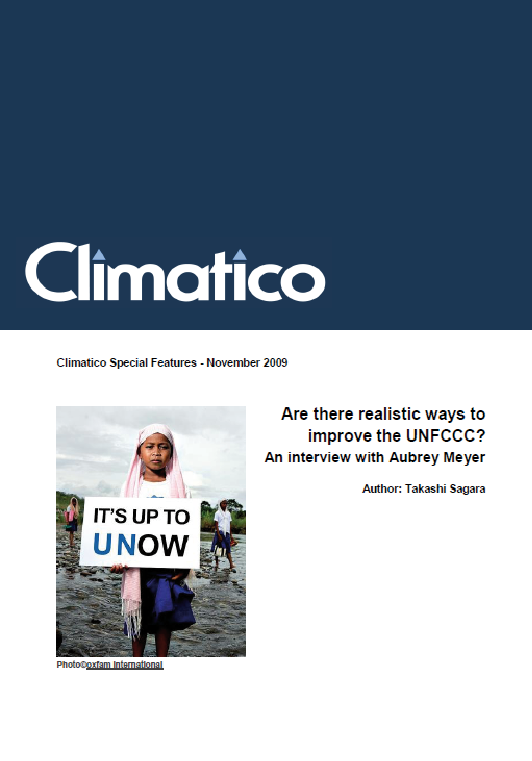
Are there realistic ways to improve the UNFCCC?
An interview with Aubrey Meyer
Author: Takashi Sagara
CLIMATICO
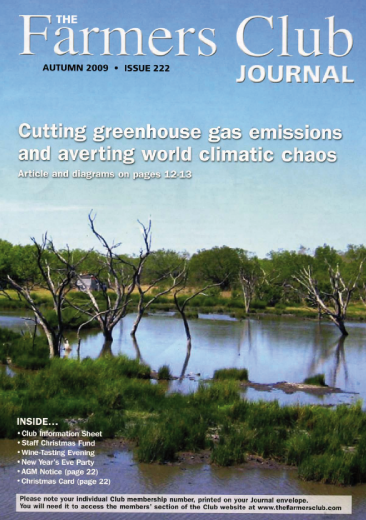
"C&C puts the goal focus of the
UNFCCC process in a structure of
reconciliation. From this it becomes
possible to go beyond the merely
aspirational character of the current debate
around the UNFCCC, to a rational and
constitutional global agreement. This is
preferable to assuming any inequality
of rights.
As the original authors of the UNFCCC
understood at the outset. embracing
this primary question of the sufficient
and indeed the proportionate response is fundamental to the whole global engagement. The Kyoto Protocol
avoided this.
Integrated approach needed: - 2009 Article_for Farmer's Club Journal
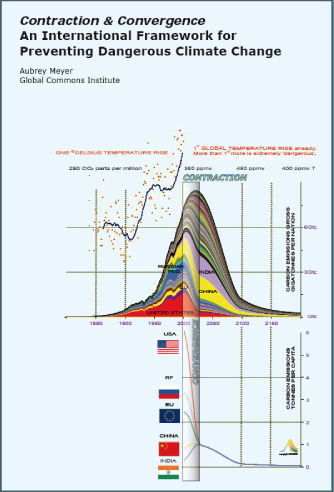
"Contraction and Convergence directly addresses the two major obstacles to real progress as the international negotiations on climate change on the UNFCCC came into force in 1995: - the double-jeopardy of asymmetric growth or 'expansion and divergence' in the past and the worsening climate damages we face in the future."
Article for ZAYED Future Energy Magaine December 2009
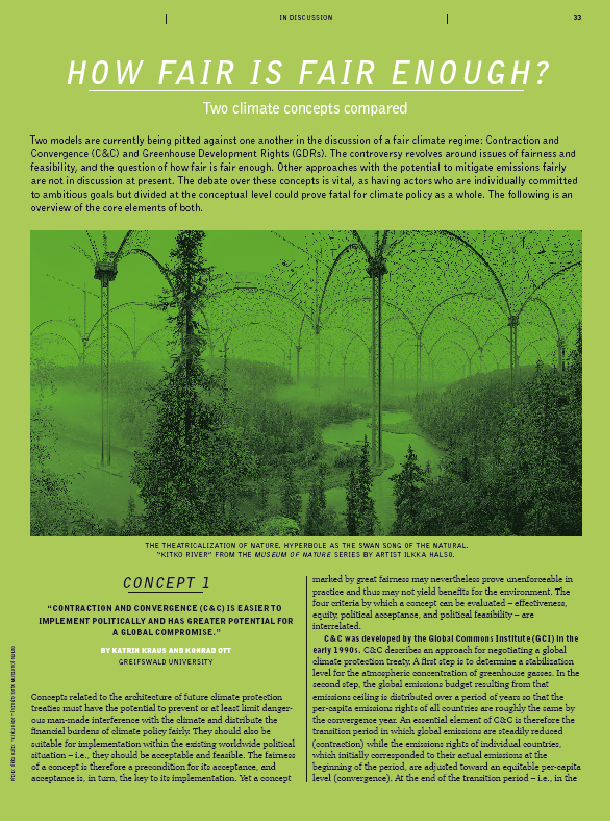
Two models are currently being pitted against one another in the discussion of a fair climate regime: Contraction and
Convergence (C&C) and Greenhouse Development Rights (GDR s). The controversy revolves around issues of fairness and
feasibility, and the question of how fair is fair enough. Other approaches with the potential to mitigate emissions fairly
are not in discussion at present. The debate over these concepts is vital, as having actors who are individually committed
to ambitious goals but divided at the conceptual level could prove fatal for climate policy as a whole. The following is an
overview in the magazine of the Heirich Boell Foundations of the core elements of both with Katrin Krause and Konrad Ott for C&C and Tilman Santarius for GDRs.
How Fair is fair Enough?
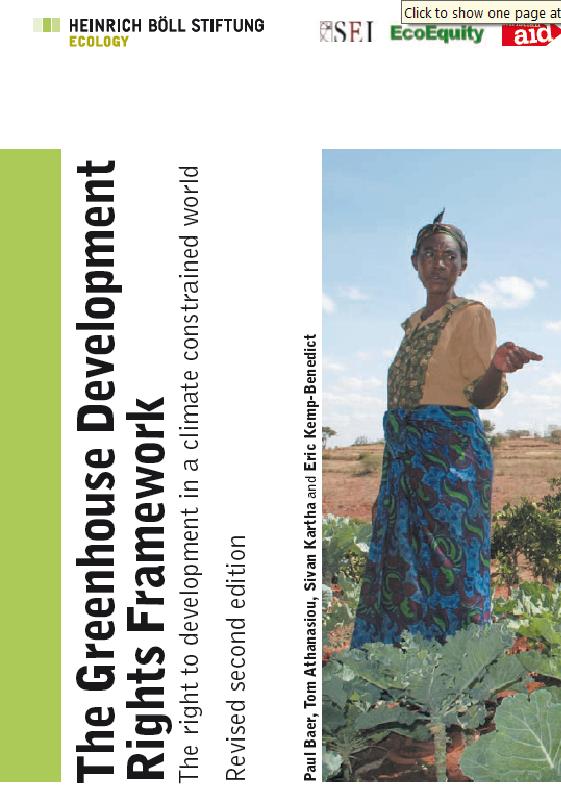
The comment by the Heinrich Boell Foundation [HBF] above reads: - "The debate over these concepts [C&C & GDRs] is vital, as having actors who are individually committed
to ambitious goals but divided at the conceptual level could prove fatal for climate policy as a whole." As the authors of the GDR Framework state, "it should be said, [GDRs] evolved from C&C the most well-known of the per-capita rights approaches."
There's no questions that GDR authors are very committed, but to take their proposal seriously, one needs also to be committed to the authors' main point, which reads: - "Under GDRs the national mitigation obligations of the high-RCI countries of the North vastly exceed the reductions they could conceivably make at home. In fact, by 2030, their mitigation obligations will typically come to exceed even their total domestic emissions! Which is to say that wealthier and higher-emitting countries would be given “negative allocations,” as is necessary in order to open enough atmospheric space for the developing world."
The authors then argue this is what distinguishes GDR from C&C: - "Incidentally, this kind of negative allocation can never arise under Contraction and Convergence style trajectories, wherein high-emitting countries are only required to transition from their high grand-fathered allocations down toward the global per-capita average."
Actually it is GDRs that starts with 'grandfathered allocations'. C&C offers a mechanism that will calculate convergence at any rate - between immediate and delayed to service whatever rate the negotiations can sustain - with an invitation to negotiators to see this and use this to come to terms. The C&C model will also calculate 'negative emissions entitlements' - but for everybody and not just Annex One Countries - after whatever date you ask it to. The GDR authors have consistently ignored these points.
But in assessing all this,the operative point is this: - *giving negative emission entitlements* to the USA requires GDR advocates to go to the US Senate and present and win this point. As this obviously not going to happen, it is the odds [not the entitlements] that are *negative* of getting the US to accept this, "in order to open enough atmospheric space for the developing world."
So adjusting the HBF comment above, it is this that may have already proved fatal for climate policy. Post COP-16 Cancun, the US has stated in response to precisely this sort or argument that a firewall now exists between North and South, that a global climate deal is not possible and there is no need for one either.
The GDR proposal and others were compared with C&C in the section 'looking at the alternatives' in this GCI post-mortem on COP-15 here. The animation compares the alternatives *quantitatively* with C&C.
The Greenhouse Development Rights Framework
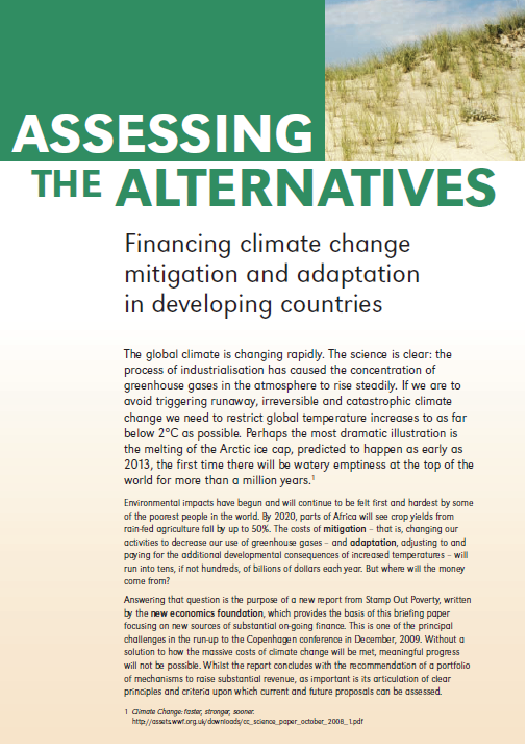
Latching on to this however, the high-minded Lords-of-Aid have never had it so good. OXFAM et al dispose of around $1,000,000,000/year pushing this kind of material while drawing - charitably extracted - salaries for their CEOs at 100s of thousands of pounds a year and using vast armies of volunteers for 'their mission'.
"It is essential that decisions on climate change financing be made on a fair and equitable basis, using clear
principles, and that national contributions should vary to reflect responsibility and capacity to pay. One
of the recognised systems by which to assess which developed countries ought to shoulder what proportion
of financial responsibility, in respect of both mitigation and adaptation, is the Greenhouse Development Rights
(GDR) framework. Fundamental to the GDR approach is firstly the need for emergency measures to reduce global
carbon emissions rapidly to avoid global temperature rise of 2°C; and secondly the overriding need for poverty
reduction in developing countries."
That 'Development' NGO's have taken some 'Climate-Action' NGOs into this army of advocacy is continuing evidence of just how dysfunctional their performance at the UNFCCC for over 20 years has now become.
OXFAM/NEF 'Assessing the Alternatives'

The transition to sustainability will not be easy,
but it is central to securing a future for biodiversity. Conservation strategies, in concert
with other environmental policies, must address
seemingly intractable and politically unpalatable
issues. In both developed and emerging economies,
we need to reduce the carbon and material
throughput demanded by current patterns of production
and consumption if we are to create viable
and democratically acceptable trajectories of
contraction and convergence in resource use. In
parallel, we must recognize that successful human development agendas are underpinned by functional
ecosystems, and by biodiversity. This is the
year in which governments, business, and civil
society could decide to take seriously the central
role of biodiversity in human well-being and quality
of life and to invest in securing the sustainable
flow of nature's public goods for present
and future generations.
Biodiversity Conservation: Challenges
Beyond 2010
Science Magazine September 2010
[This was - unusually - a genuinely thoughtful, searching and intelligent bit of 'climate-change-journalism'. Its just a pity that Richard quoted the tactically rather extreme December 2008 Report by Jihua Pan from the Chinese Academy of Social Sciences, rather than the strategically smarter July 2009 Report from the Chinese Government which made the case for C&C at rates consistent with equity and an intelligently correct understanding of the C&C model*. Richard's article preceded that report by four months].
Anyway his piece correctly laid out the case . . .
"The issue is this: how much carbon dioxide should each person on Earth be "allowed" to emit?
Put another way: if emissions of CO2 and other greenhouse gases are to be limited, at some target date, to a figure that science suggests can stave off "dangerous" climate change, then how does that figure break down at the personal level, when shared out among the world's citizens?
The figure that was being bandied about at COP-15 is two tonnes of CO2 (or its equivalent) per person per year. It's derived from the ambition of halving global emissions by 2050 compared with 1990 levels, as expressed by G8 leaders during their summit in Japan.
In turn, this may be enough to constrain the global average temperature rise to within 2-3C at most, which according to the Intergovernmental Panel on Climate Change (IPCC) would avoid many of the most damaging projected impacts.
Currently, the average Briton produces about 10 tonnes per year - the average US citizen more, the average Chinese or Indian considerably less. So a great deal of convergence is implied, and I should be remiss if I did not point up here the important role of Aubrey Meyer and the Global Commons Institute in developing the concept of Contraction and Convergence.
So let's go back to the original question; how much carbon dioxide should each person on Earth be 'allowed' to emit? Two tonnes by 2050 might be a starting point for discussions; but precisely how much, and by what means, are clearly questions where important nuances pertain.
Where there are grey areas, there is also much room for political wrangling; and of course any agreement on contraction and convergence towards some figure like two tonnes, with whatever caveats, in the end has to be negotiated between governments."
Richard Black - Carbon: How much is enough?
* It was the disastrous mishanding of the issue of *the rates of C&C* at COP-15 - particularly the diktat from Ed Miliband and the team from DECC that convergence must be by 2050 - that almost certainly led to the hugely acrimonious row that broke out [reported by John Vidal in the Guardian] almost immediate the diktat was 'leaked' to the conference on day two.
Ed Milliband was the Minister at the UK Department of Environment and Climate Change [DECC]. He oversaw the introduction into law of the UK Climate-Act in 2008. This prescribed a global convergence-rate to equal per capita shares globally that completed by 2050. This was inside a global emissions contraction rate that peaked in 2016 and declined to zero emissions by the end of the Century.
~~~~~~~~~~~~~~~
Ed Miliband gave evidence to the Environmental Audit Select Committee [EAC] in October 2009, more than a year after the Climate Act had been in force and on the eve of taking the rates of C&C in the UK Climate-Act to COP-15 in Copenhagen in December 2009.
This prescription became known as the 'Danish Draft' and it was put forward by a group of Governments led by the UK at COP-15, with the claim that it would avoid exceeding an overal temperature rise of two degrees Celsius above pre-industrial and meet the requirements of equity.
The EAC Chairman asked him, "Will C&C feature in the negotiations at COP-15?"
"I think probably not is the answer," replied Mr Miliband. He went on, "I do not think that will form the basis of an agreement. I think that there is a sort of attractive justice element to the contraction and convergence idea. The complexity of it, though, is what is the point at which convergence takes place and what do we say about different countries' levels of growth at that point, GDP, how should we adjust for different weather conditions and all that?
Miliband appeared to be completely unaware that the convergence date of 2050 had already been turned into UK Law with UK Climate Act, an act largely scripted by DECC and the Climate Change Committee. He was also apparently unaware that the Chinese Government had proposed immediate convergence of emissions entitlements in July 2009.
But Mr Miliband then went further than that. He came home from the fiasco at COP-15 that he and DECC largely caused with their prescription, and using the Guardian newspaper, publicly accused the Chinese Government of having wrecked the COP-15 negotiations, because they had rejected DECC's convergence rate.
The obvious scientific and political falseness of the UK Government's claims to satisfy the demands of equity and urgency with this prescription, more than probably explains why the whole thing was rejected outright by Developing Country Governments at COP-15.
~~~~~~~~~~~~~~~~~~~~

Prince Charles had the ideal opportunity to engage with the RIBA on the
overriding Issue of climate change, but he fluffed it, says Aubrey Meyer.
C&C_and Prince Charle's visit to RIBA: - 2009 Article_for RIBA Journal

The only way out of the impasse
was an equitable plan: for rationing
to work, it would have to be just. For
years, there had been multiple blueprints.
But to get one adopted, people round
the world would have to demand it. So
the deal had to sound reasonable to
all of them. Perhaps the best-known
model was Contraction & Convergence
(C&C). Like healthy sex, its inventor
quipped, it started with three basic
questions. Is it consensual, is it safe,
and is it fair to third parties?
Financial Times - World Survives Equal Rights Day
APRIL FIRST 2020
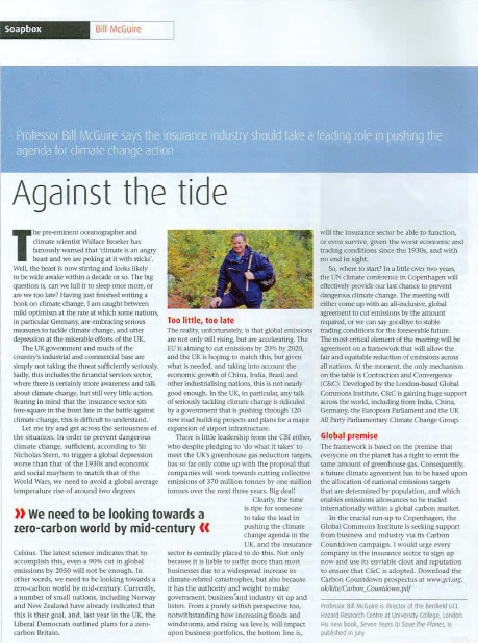
So, where to start? In a little over two years, the UN climate conference in Copenhagen will effectively provide our last chance to prevent dangerous climate change. The meeting will either come up with an all-inclusive, global agreement to rut emissions by the amount required, or we can say goodbye to stable trading conditions for the fo reseeable future. The most critical element of the meeting will be agreement on a framework, that will allow the fair and equitable reduction of emissions across all nations.
At the moment, the only mechanism on the table is Contraction and Convergence (C&C). Developed by the London-based Global Commons lnstitute, C&C is gaining huge support across the world, including from India, China, Germany, the European Parliament and the UK All Party Parliamentary Climate Change Group.
Global premise -
The framework is based on the premise that everyone on the planet has a right to emit the same amount of greenhouse gas. Consequently, a future climate agreement has to be based upon the allocation of national emissions targets that are determined by population, and which enables emissions a!lowances to be traded internationally within a global carbon market. In the crucial run-up to Copenhagen, the Global Commons Institute is seeking support from business and industry via its Carbon Countdown campaign. I would urge every company in the insurance sector to sign up now and use its enviable clout and reputation to ensure that C&C is adopted. Download the Carbon Countdown prospectus.
Against the Tide Bill McGuire in 'the Actuary' October 2008

It is clear, given the enormity of the challenge, that the worst of climate change can only averted if the world can make a rapid transition to a non-carbon energy economy. The nations of the world would then have almost unlimited environmental space at least in the foreseeable future to use energy for their economic growth. The world needs an international mechanism that not only provides incentives to all nations to live within their entitled amounts but also helps to promote a rapid transition to a non-carbon energy economy. The principles of contraction and convergence-- the rich to reduce, while the poor to grow--and equal per capita entitlements--living within limits--would be the basis of future global agreement.
What equals effective
Down to Earth December 15th 2007
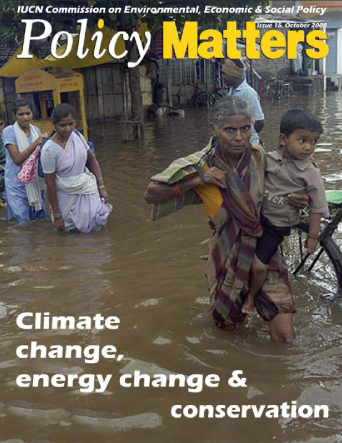
Contraction and Convergence (C&C) is a global framework for reducing GHG emissions to a safe
level. C&C was designed by the Global Commons Institute for the Intergovernmental Panel on
Climate Change and the UN Framework Convention on Climate Change.12 Longtime industrialised
countries, which have produced the bulk of greenhouse gases, bear a much larger burden in
preventing climate change; therefore they will have to play a leadership role, both regarding
drastic emissions reduction and development of low- or no-carbon technologies to provide room
to poor developing countries for economic development within the boundaries of a global carbon
regime.
C&C is based on the science of limits and the principle of carbon justice, striving for convergence
to equal-per-capita emissions rights, assisted by a medium-term, multistage approach
accounting for differentiated national capacities. 'Contraction' means global emissions are
reduced in total over time so the concentration of greenhouse gas in the atmosphere stabilises at
a level low enough and soon enough to prevent dangerous rates of climate change from taking
hold. 'Convergence' means that subject to this global limit, initial entitlements to emit carbon
are distributed to all the countries or regions of the world with an agreed process of convergence
to equalise per capita emissions entitlements across the planet.
During contraction and convergence, entitlements are assumed to be tradable and hence must
be capped, with quotas initially distributed to the government, which then auctions them to users
who are allowed to re-sell them. C&C also could work using the carbon tax rather than cap and
auction-and-trade.
Policy Matters IUCN -
Climate
change
and the
energy
crisis
Robert Goodland and Simon Counsell
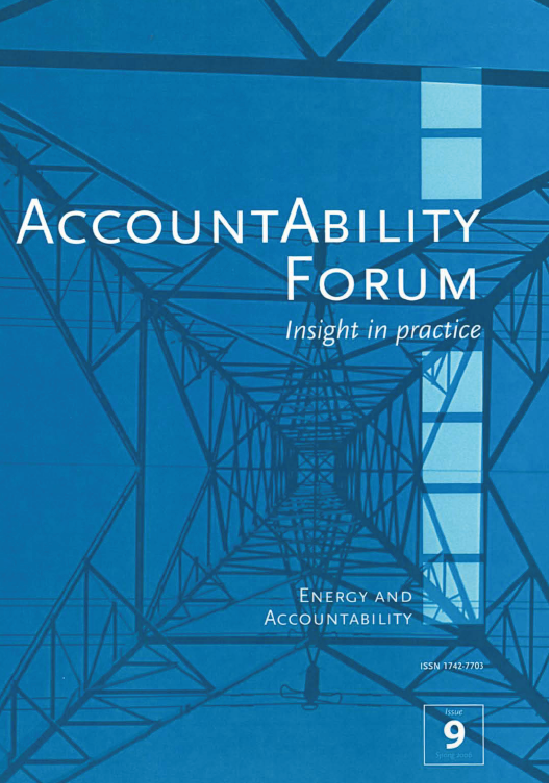
From understanding the problem to
addressing the problem.
Currently, the global community
continues to generate dangerous
climate cha nge faster than it organises
to avoid it. The international
diplomatic challenge is to reverse this.
Key to this is a fundamental
rebuilding of our framework for
accountable energy use. Aubrey Meyer has campaigned at
the United Nations climate change negotiations since 1990.
For this he has won the Andrew
Lees Memorial Award, the
Schumacher Award and the City
of Londonl Lifetime Achievement
Award 'for an outstanding
personal contribution to
combating climate change at the
international level'. The New
Statesman describes him as 'one
of the ten people who will change
the world'.
Accountability Magazine - Contraction and
Convergence:
A Framework
for Accountability on Climate
Change and Energy Use
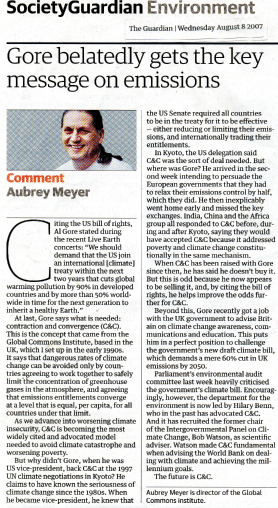
Gore Belatedly Gets Key Message on Emissions Wednesday August 8 2007
"Citing the US bill of rights, Al Gore stated during the recent Live Earth concerts: "We should demand that the US join an international [climate] treaty within the next two years that cuts global warming pollution by 90% in developed countries and by more than 50% worldwide in time for the next generation to inherit a healthy Earth." At last, Gore says what is needed: contraction and convergence (C&C). This is the concept that came from the Global Commons Institute, based in the UK, which I set up in the early 1990s. It says that dangerous rates of climate change can be avoided only by countries agreeing to work together to safely limit the concentration of greenhouse gases in the atmosphere, and agreeing that emissions entitlements converge at a level that is equal, per capita, for all countries under that limit."
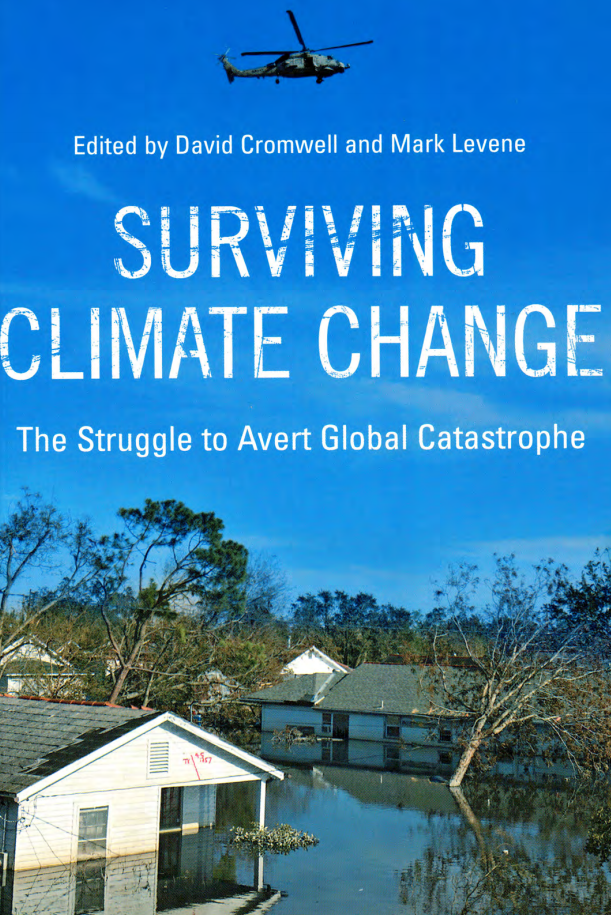
C&C_Chapter in Mark_Levene_'Surviving Climate Change'
"I was born in the UK in 1947. I grew up in South Africa in the
'apartheid era' after the Second World War. 'Unity is Strength'
was the motto of the then White Nationalist government of the
country, yet 'Separate Development' was their decreed strategy. Even
to a child, the segregation or 'apartheid' under this unity was
a political oxymoron. This divided and asymmetric state made the
Beloved Country weak for the lack of unity. This lesson now applies
to our beloved but divided planet. Change is inevitable. May it be
moderated for the better, even as we integrate cost and benefi ts of
'development' in the struggle to avoid the worst of global warming
and climate change."
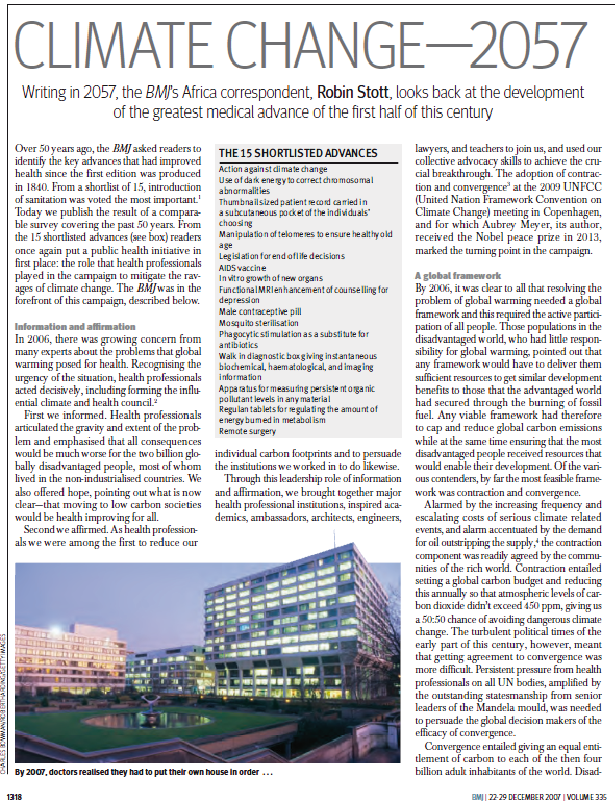
A global framework
By 2006, it was clear to all that resolving the problem of global warming needed a global framework and this required the active participation of all people. Those populations in the disadvantaged world, who had little responsibility for global warming, pointed out that any framework would have to deliver them sufficient resources to get similar development benefits to those that the advantaged world had secured through the burning of fossil fuel. Any viable framework had therefore to cap and reduce global carbon emissions while at the same time ensuring that the most disadvantaged people received resources that would enable their development. Of the various contenders, by far the most feasible framework was contraction and convergence. Through this leadership role of information and affirmation, the Medical Health Council brought together major health professional institutions, inspired academics, ambassadors, architects, engineers, lawyers, and teachers to join us, and used our collective advocacy skills to achieve the crucial breakthrough. The adoption of contraction and convergence at the 2009 UNFCC (United Nation Framework Convention on Climate Change) meeting in Copenhagen, and for which Aubrey Meyer, its author, received the Nobel peace prize in 2013, marked the turning point in the campaign.
Dr Robin Stott British Medical Journal
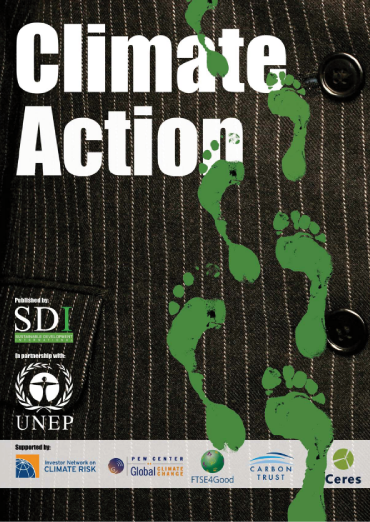
Climate Action 2007 C&C
"Technically, the C&C model is a coherent and
mathematically-stable framework. It holds the science policy
content together as a unity, science-based on the
contraction side of the argument and rights-based or
'constitutional on the 'political' side of the argument.
C&C is in effect a bill of rights, It simply plots a full-term
event for achieving equal per capita emissions rights
globall [Convergence] but governed by the overall
emissions limit over time that stabilises the atmosphere
concentration of GHG at a 'safe' value [Contraction]. The UNFCCC makes C&C generically true, but C&C
specifically embraces a calculus built on this truth."

The United Nations Framework Convention on Climate Change(UNFCCC) was agreed in 1992. By the UNFCCC's Kyoto Protocol, adopted at the third session of the Conference of the Parties, in Kyoto, Japan, in 1997, the developed countries nations agreed to limit their greenhouse gas emissions relative to levels emitted in 1990. The objective is, of course, to stabilise the rising concentration of greenhouse gas (GHG) in the atmosphere before this becomes 'dangerous'. However, the Kyoto agreement is partial, not going far enough to meet scientifically assessed needs for GHG emission reductions. Unlike Kyoto, Contraction and Convergence (C&C) - the basis proposed by the Global Commons Institute (GCI) for international agreement to control greenhouse gas emissions - addresses the problem in its entirety.
Shrinking the carbon economy
One World
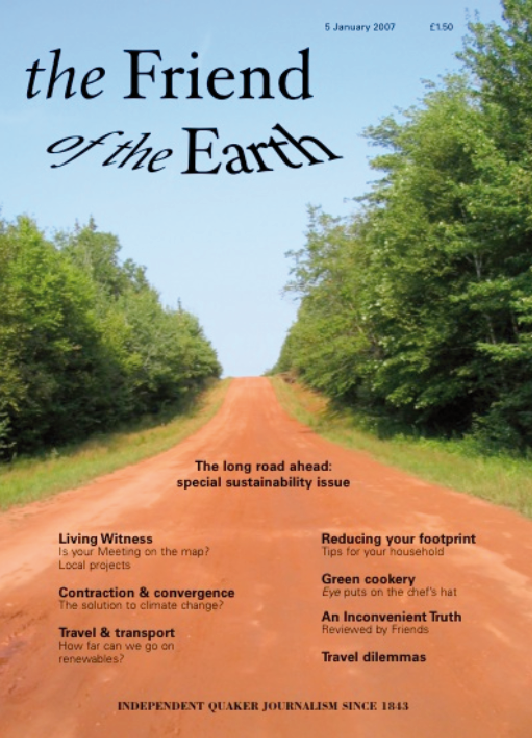
Imagine a solution to climate change which would simultaneously tackle global poverty and inequality. Aubrey Meyer's 'Contraction and Convergence' proposal could be an answer to both. Contration and Convergence could play a major role in reducing climate change and in reducing the growing gap betwecn rich and poor. The idea that everyone has rights to air, a global commons given us by God, fits with the Quaker Testtmony to Equality. Could Quakers lead the way as we have in the past? What might that mean? Dare to imagine your PM building Contraction and Convergence into its Finance and Property Group, perhaps sending donations to poor countries to pay for all excess carbon emissions! How might Contraction and Convergence affect Friends House? Meeting for sufferings? We cannot continue with business as usual. Our Quaker testimonies to Simplicity, Equality, Sustainability and Peace provide us with a basis for action. Can Quakers lead the way in championing this as we did the abolition of the slave trade?
Quaker Magazine - The FRIEND
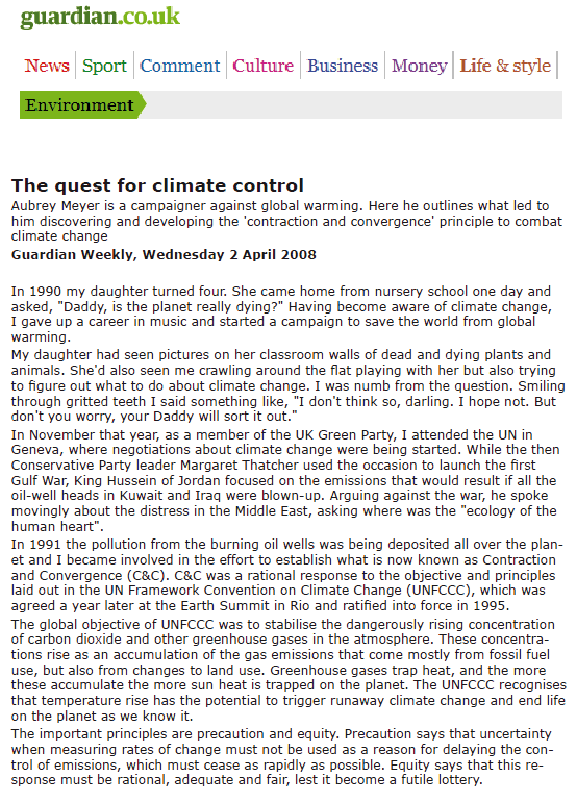
Aubrey Meyer is a campaigner against global warming. Here he outlines what led to him discovering and developing the 'contraction and convergence' principle to combat climate change.
The quest for climate control
Aubrey Meyer The Guardian, 2 April 2008

The negotiations on climate change at the UN over nearly twenty years have proved to be an increasingly bewildering exercise in the complexity of avoidance. So Caroline Harmon's commentary on Contraction and Convergence is welcome. She said, "[C&C] offers a stunningly simple way of applying the same environmental standards to all." C&C was put forward many years ago. It was partly in the spirit of the Santa Fe Institute [to the effect], 'beneath all complexity lies a deep simplicity'. The nearest we all came during that time to getting global agreement in terms of C&C was at 'COP-3'to the UN Climate Treaty in Kyoto in 1997. In simple terms, the US, China, the Africa Group of Nations and India saw C&C and the US Senate's *Byrd Hagel Resolution* as compatible and said so to the record However, some 'green governments and non-government organisations' preferred 'Kyoto's' complex fire-fights as preferable and the moment was lost. Even still now ten years on, we continue to cause the 'climate-problem' faster than we respond to avoid it. The import of this seems still to be less than fully appreciated. The objective of the UN Climate Treaty requires that our ghg emissions fall globally, yet still they rise. While this is now generally understood, what is less well understood is that, even were they to fall to nearly zero globally [contraction] and be shared internationally, 'rationally' [convergence], this full-term integral of 'contraction and convergence' still needs to be as a rate 'fast-enough' - say by 2060 - or as a weight 'light-enough' - say burning one last .25 trillion tonnes carbon - to avoid the runaway effects of doing this too slowly which will be to influence many of the natural sinks and/or stocks for these gases turn and become their sources as temperature rises further. Going to 'COP-15' next year for 'the global deal' that is supposed to save us all from the imminently dangerous rates of global climate change, we probably have another [is it the last?] chance to re-establish such an agreement. The key is to turn Kyoto's so-called 'market-based framework' into C&C's 'framework-based market'.
Here
are references relating to that narrative. The opportunity is still 'viable'; see revisable C&C rates v-a-v sink failure; see campaign and support for C&C in 2008.
Helium
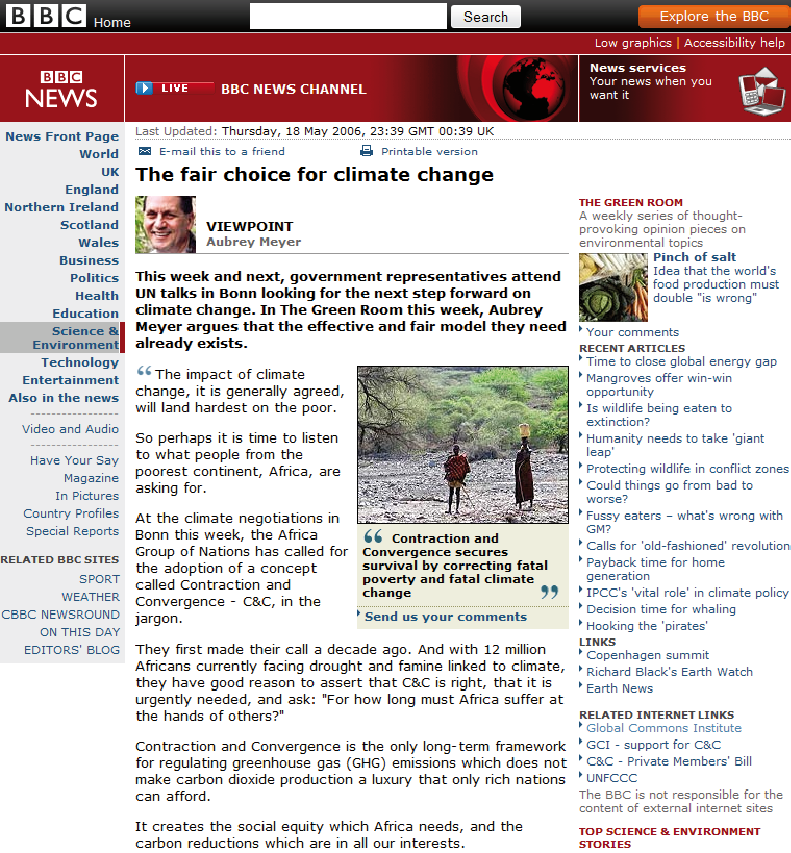
This week and next, government representatives attend UN talks in Bonn looking for the next step forward on climate change. In The Green Room this week, Aubrey Meyer argues that the effective and fair model they need already exists. The impact of climate change, it is generally agreed, will land hardest on the poor. So perhaps it is time to listen to what people from the poorest continent, Africa, are asking for.
At the climate negotiations in Bonn this week, the Africa Group of Nations has called for the adoption of a concept called Contraction and Convergence - C&C, in the jargon.
They first made their call a decade ago. And with 12 million Africans currently facing drought and famine linked to climate, they have good reason to assert that C&C is right, that it is urgently needed, and ask: "For how long must Africa suffer at the hands of others?" Contraction and Convergence is the only long-term framework for regulating greenhouse gas (GHG) emissions which does not make carbon dioxide production a luxury that only rich nations can afford.
It creates the social equity which Africa needs, and the carbon reductions which are in all our interests.
BBC Viewpoint
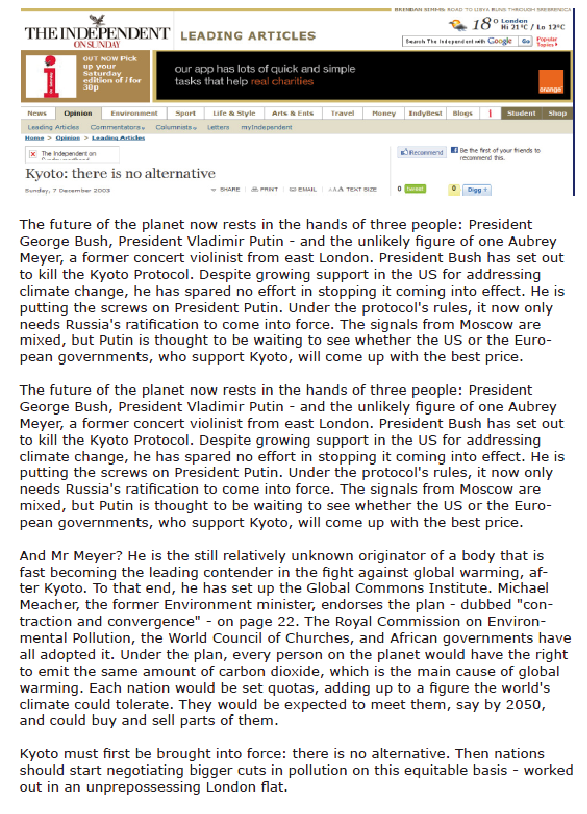
"The future of the planet now rests in the hands of three people:
President George Bush, President Vladimir Putin - and the unlikely figure of one Aubrey Meyer,
a former concert violinist from east London."
Leader in the Independent on Sunday 07 December 2003
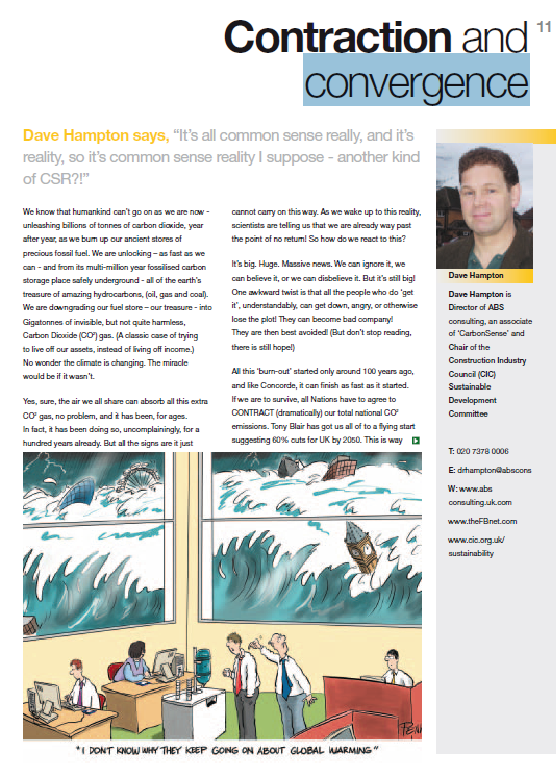
Dave Hampton says, "It's all common sense really, and it's reality, so it's common sense reality I suppose - another kind of CSR?!"
Contraction and Convergence

New Statesman Energy Supplement
This brings us to "contraction and convergence" (C&C). Advocated by a small British group called the Global Commons
Institute, which is seeking a trademark for the term, this formula for future global emissions could, without exaggeration,
save the world. The contraction half of the formula cuts
global emissions year on year so we never go above the critical
trillion-tonne threshold of carbon dioxide in the atmosphere.
The convergence half brings about a gradual convergence of
national emissions entitlements, according to population.
The logic is compelling, but some say it
is fantasy politics. Big environment groups such as Greenpeace see the formula as a political dead end. I think they
are profoundly wrong.
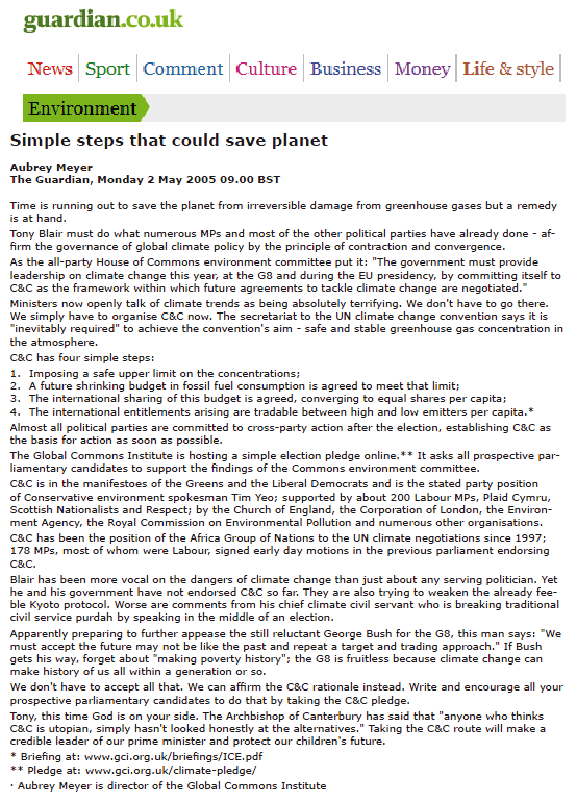
Time is running out to save the planet from irreversible damage from greenhouse gases but a remedy is at hand. Tony Blair must do what numerous MPs and most of the other political parties have already done - affirm the governance of global climate policy by the principle of contraction and convergence.
Simple steps that could Save the Planet
Aubrey Meyer The Guardian, Monday 2 May 2005 09.00 BST
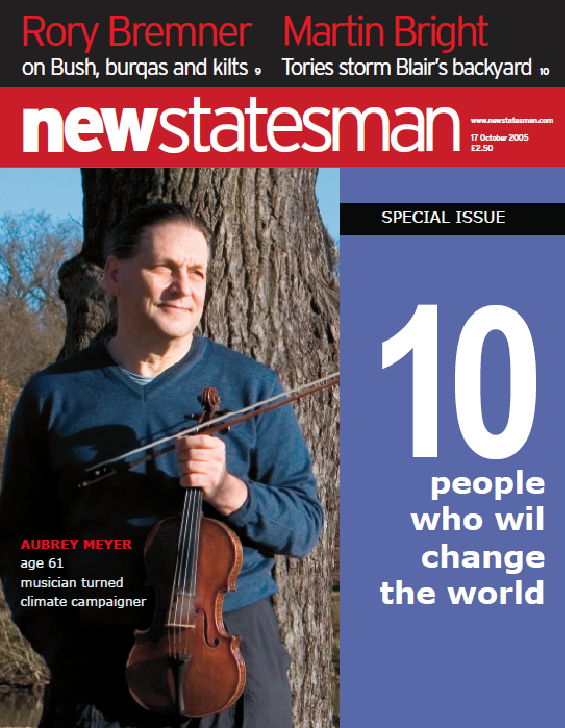
"From the African Union nations to the European Parliament,supporters are queuing up for C&C, and it may be only a matter of time before Kyoto's 'Plan B' becomes the guidingprinciple at the UN climate negotiations. Indeed, it is difficult to visualise a final agreement that does not incorporate the basicprinciples of C&C. 'Equity and survival' is the catchphrase of Meyer's organisation, the Global Commons Institute. If equity is implemented, future generations may well have Aubrey Meyer to thank for their survival."
DOES THIS EX-MUSICIAN HOLD THE ANSWER TO THE WORLD�S CLIMATE CRISIS?
BY MARK LYNAS - New Statesman
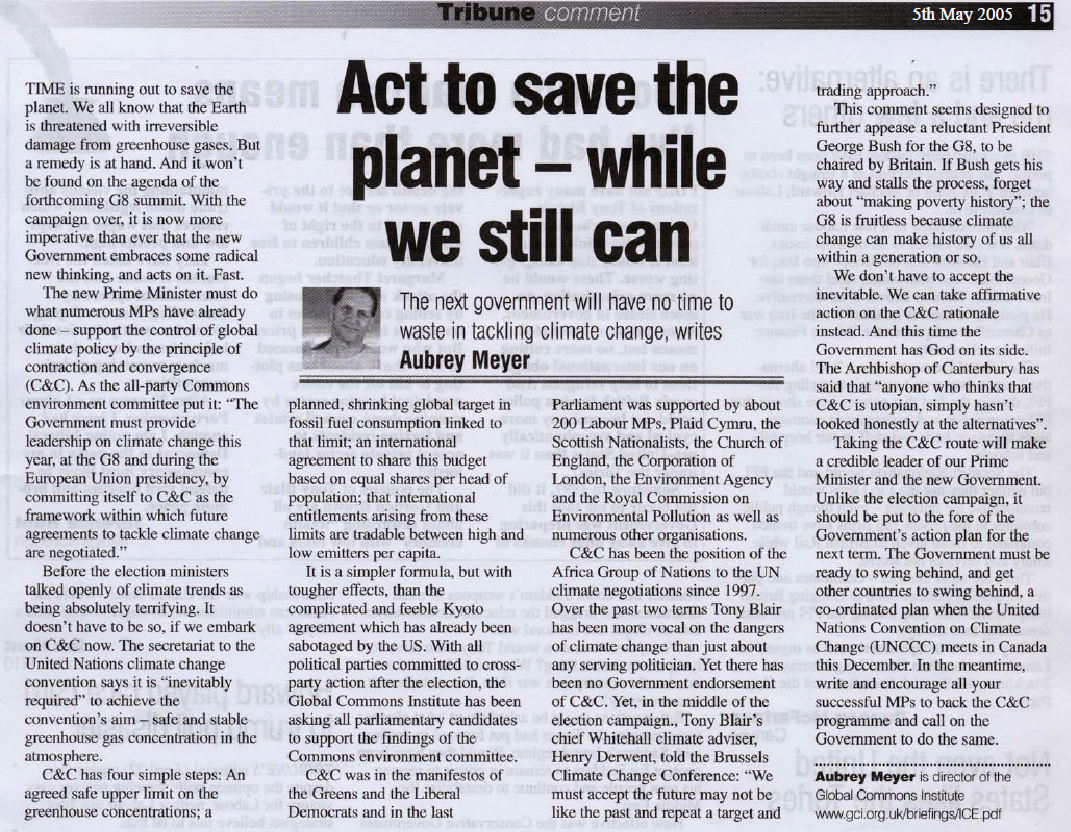
We don 't have to accept the
inevitable. We can take affirmative
action on the C&C rationale
instead. And this time the
Government has God on its side.
The Archbishop of Canterbury has
said that, "anyone who th inks that
C&C is utopian, simply hasn't
looked honestly at the alternatives".
Tribune May 2005

When the most powerful woman on the planet speaks, it's a good idea to listen. Chancellor Angela Merkel of Germany, who recently knocked Condoleezza Rice off Forbes's top spot for powerful women, suggested an innovative solution to climate change late last month. Speaking in the Japanese city of Kyoto, where the 1997 protocol was signed, the German chancellor proposed an equal-rights framework for carbon emissions, where each country would get emissions entitlements assigned on the basis of its population. The UK's Environment Secretary, Hilary Benn, shows no sign of having heard Merkel's words. The idea that a global deal to reduce greenhouse-gas emissions must involve a convergence to equal per-capita allocations is not new: it is textbook "contraction and convergence" (C&C) - a climate policy framework first advanced by Aubrey Meyer of the Global Commons Institute more than a decade ago, and subsequently supported by numerous influential people, from the Indian prime minister to the Archbishop of Canterbury. As Merkel pointed out, only C&C offers a fair basis for bringing developing countries such as India and China into a future post-Kyoto emissions framework. Yvo de Boer, the UN's top climate-change official, believes the plan to be the "only equitable, ultimate solution".
New Statesman

A Man for all Seasons: LEXUS Magazine Interview
"The Global Commons Institute sounds as though it should be a grand organisation with a fine headquarters. The institute is at the forefront of the fight against the growing threat of global warming and lobbies scientists, the media and politicians to listen to its ideas. It publishes glossy brochures, distributes them at all the key climate events, and its ideas are backed by an impressive roll call of supporters, including presidents and prime ministers. In fact, the Global Commons Institute is a small association led by one man, working from a plain house in northeast london. That man is aubrey meyer, and from his home he has devised the answer to the world's biggest problem. meyer is not a physicist, economist or green technology guru, he is a musician a very good one and his idea to address global warming, called 'Contraction and Convergence' (C&C) is striking a chord across the globe. Britain's Guardian newspaper recently named him one of the 50 heroes of the planet and New Statesman magazine placed him among the 10 people most likely to change the world."
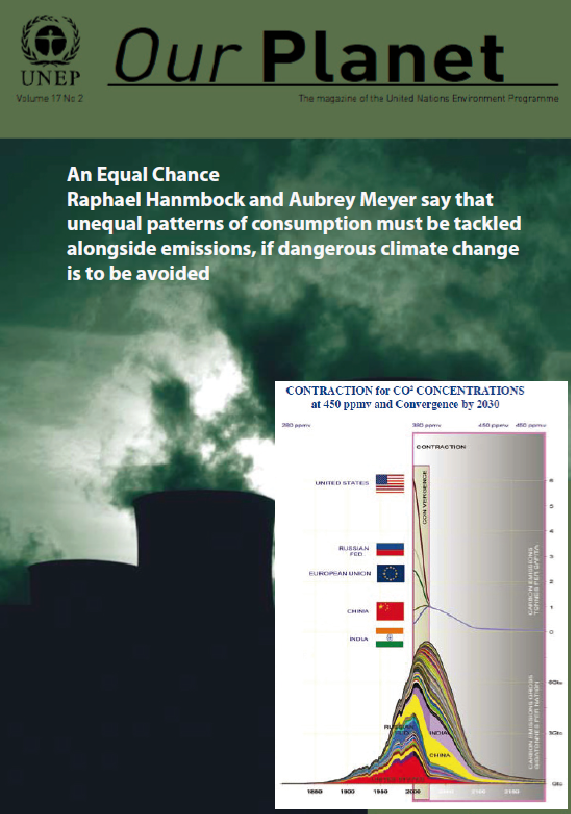
An Equal Chance -
Raphael Hanmbock and Aubrey Meyer say that unequal patterns of consumption must be tackled alongside emissions, if dangerous climate change is to be avoided.
UNEP Our Planet Magazine

The human economy emits vast amounts of greenhouse gas by burning oil, coal and gas. The sharply increasing volume of these emissions is accumulating in the atmosphere, accelerating the rise in their atmospheric concentration. This traps more heat-energy from the sun and dangerous rates of climate change with devastating damages are in prospect. As Jim Lovelock suggested, failing to stem this trend means civilization may be completely overwhelmed during the decades ahead.
To avoid this we have to solve the problem faster than we create it. Globally, we have to achieve the goal of the United Nations Framework Convention on Climate Change (UNFCCC) agreed in 1992, by drastically cutting greenhouse emissions. The agreed objective of the UNFCCC is the stabilisation of greenhouse gas concentration in the global atmosphere at a level that is ‘safe’. These cuts or the international emissions “Contraction and Convergence” (C&C) [see below] are required by definition.
C&C is like turning off the taps to a bath that is about to overflow. Merely hoping to do this, or as bureaucrats say, being ‘aspirational’ about this, is deluded. In the analogy the atmosphere is the bath, the emissions are the taps and the impending overflow is what will wash civilization away unless we replace hope with C&C.
After fifteen years of aspirational politics, the taps are open wider than ever and the bath is nearly full. The global quarrel about who should turn off a tap first continues. The Kyoto Protocol mediates this by restricting some emissions measured in millions of tonnes, while ongoing global emissions accumulate in the atmosphere in billions of tonnes. The result is that concentrations, temperature and damages are now rising faster than ever. Worse, the atmosphere now appears to be retaining a larger fraction of each year’s emissions than the historic average of 50% and this, due to failure of the natural sinks for the gases, seems set to increase. As we continue to accelerate the problem much faster than we act to resolve it, Kyoto is kerb-crawling and Jim’s pessimism is justified.
C&C - PUTTING THE RATIONAL INTO ASPIRATIONAL
Network 2015 Aubrey Meyer
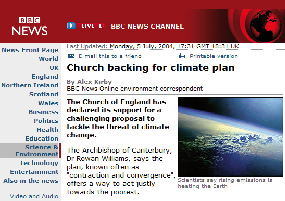
The Church of England has declared its support for a challenging proposal to tackle the threat of climate change. The Archbishop of Canterbury, Dr Rowan Williams, says the plan, known often as "contraction and convergence", offers a way to act justly towards the poorest. The idea, hatched by the Global Commons Institute, says all the Earth's people have equal rights to cause pollution. Already endorsed by other faith groups, it says nobody, however rich, should cause more than their allotted share.
"Contraction" means cutting the world's output of the gases (like carbon dioxide) which scientists believe are threatening to heat the atmosphere to dangerous levels. "Convergence" means sharing out between countries the amount of climate pollution which the scientists say the Earth can tolerate, so that by perhaps 2050 every person in the world is entitled to emit the same amount of pollution.
Dr Rowan Williams
|
Alex Kirby BBC
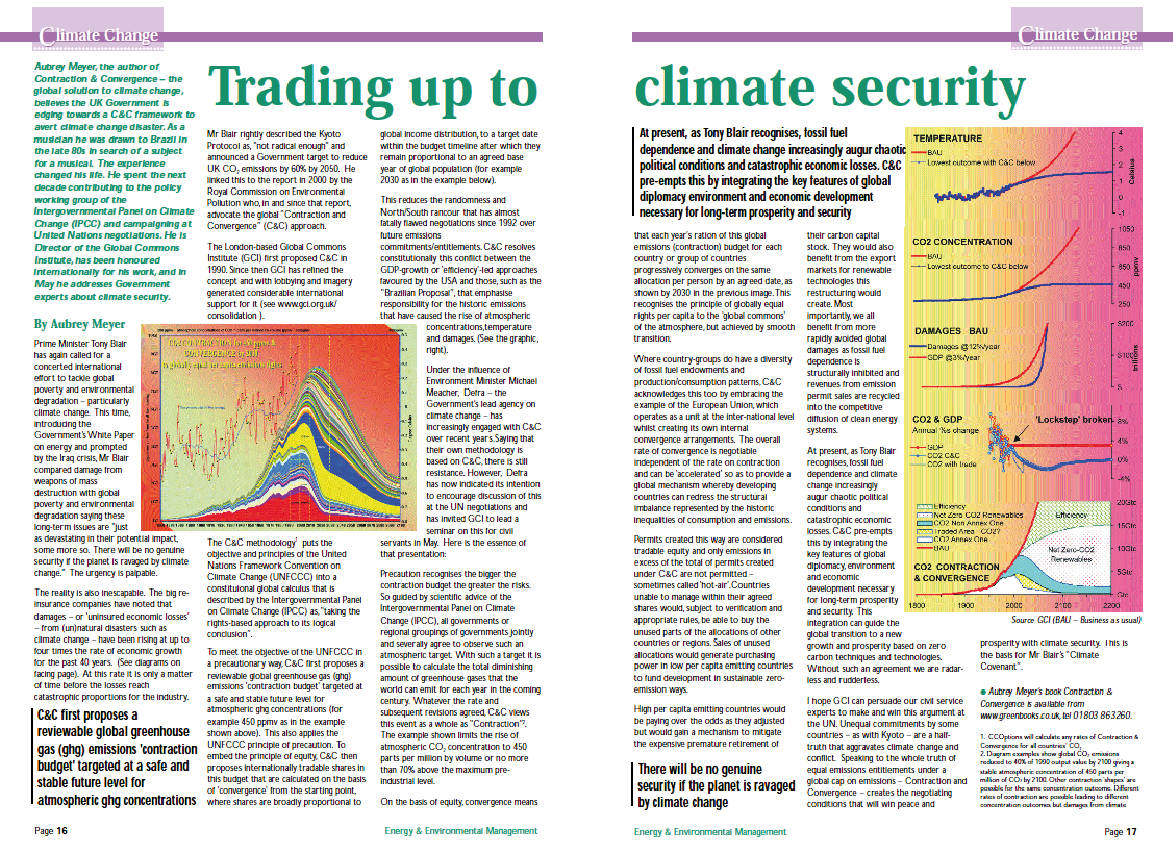
Aubrey Meyer, the author of
Contraction & Convergence the global solution to climate change, believes the UK Government is edging towards a C&C framework to avert climate change disaster.As a musician he was drawn to Brazil in the late 80s in search of a subject for a musical. The experience changed his life. He spent the next decade contributing to the policy working group of the Intergovernmental Panel on Climate Change (IPCC) and campaigning at United Nations negotiations. He is Director of the Global Commons Institute, has been honoured internationally for his work, and in May he addresses Government experts about climate security.
Trading Up to Climate Security
Energy and Environment Magazine
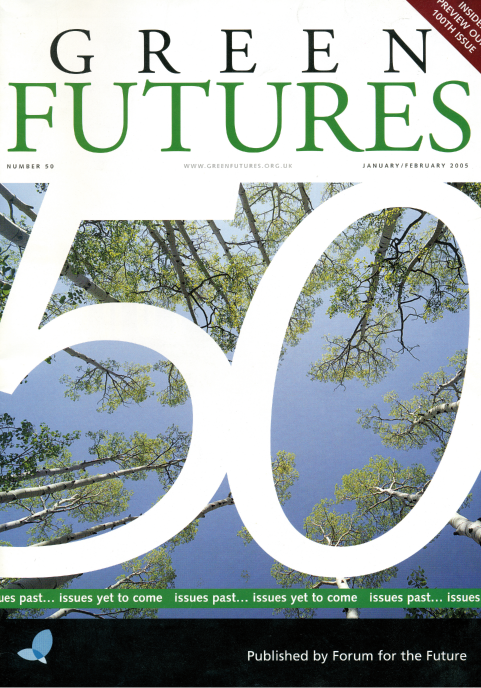
Green Futures Interview
"Most mavericks who plan global salvation from the
upstairs room of a small terraced house in Walthamstow
can reliably be written off as two bricks short
of a load.
Not so Aubrey Meyer. A classical musician with a
head for maths, he might easily be dismissed as the
last of the gentleman amateurs, if he hadn't gradually
built up a vast swell of support for his disarmingly
simple plan to tackle climate change. Its converts
include such unlikely bedfellows as Jacques Chirac,
the archbishop of Canterbury and the government of
China, and it's increasingly being seen as the muchneeded
'Plan B' to succeed (or even rescue) the
struggling Kyoto protocol."
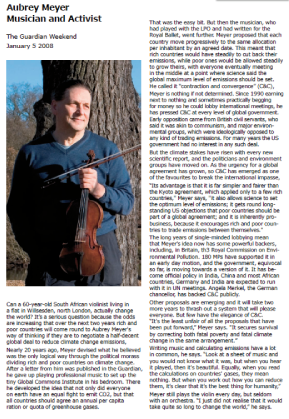
Guardian Interview
"Nearly 20 years ago, Meyer devised what he believed was the only logical way through the political morass dividing rich and poor countries on climate change. After a letter from him was published in the Guardian, he gave up playing professional music to set up the tiny Global Commons Institute in his bedroom. There he developed the idea that not only did everyone on earth have an equal fight to emit CO2, but that all countries should agree an annual per capita ration or quota of greenhouse gases. That was the easy bit. But then the musician, who had played with the LPO and had written for the Royal Ballet, went further. Meyer proposed that each country move progressively to the same allocation per inhabitant by an agreed date. This meant that rich countries would have steadily to cut back their emissions, while poor ones would be allowed steadily to grow theirs, with everyone eventually meeting in the middle at a point where science said the global maximum level of emissions should be set. He called it 'contraction and convergence' (C&C), Meyer is nothing if not determined. Since 1990 earning next to nothing and sometimes practically begging for money so he could lobby international meetings, he has pressed C&C at every level of global government. Early opposition came from British civil servants, who said it was akin to communism, and major environ-mental groups, which were ideologically opposed to any kind of trading emissions. For many years the US government had no interest in any such deal. But the climate stakes have risen with every new scientific report, and the politicians and environment groups have moved on. As the urgency for a global agreement has grown, so C&C has emerged as one of the favourites to break the international impasse."

Climate change is a cause for grave concern. As a matter of urgency, we must reconcile ourselves to committed action to stop aggravating these changes. This means curtailing our emissions of greenhouse gases rapidly enough to halt their further accumulation in the atmosphere. Failing to do this will raise severe costs for this generation - and potentially incalculable costs for future generations. Sadly the random, sub-global and inadequate nature of the Kyoto Protocol negotiations has arguably worsened the chances of success. They have failed to provide an adequate or effective global template for further action. To achieve success, we propose "Contraction and Convergence" as the basis for this reconciliation. Based on the scientific understandings of the Intergovernmental Panel on Climate Change, the approach is a full-term global framework which will share the task of halting the accumulation of greenhouse gases. It is based on the principle that an equal quota of greenhouse gas emissions should be allocated for every person on the planet. After scientists have agreed how much CO2 pollution the planet can withstand, every person in the world would be allocated an "emission quota". In other words each person would be allowed to emit an agreed amount of CO2, in order to keep the accepted global level constant. In practice, rich countries would have to "contract", or reduce, their emissions; while poor countries could actually increase theirs, so that global emissions "converge" at equal, accepted levels. This is the first step in building a constitution. This has been described as "taking the rights-based approach to its logical conclusion".
A grave concern - but Kyoto is not the answer
Aubrey Meyer, Director, Global Commons Institute
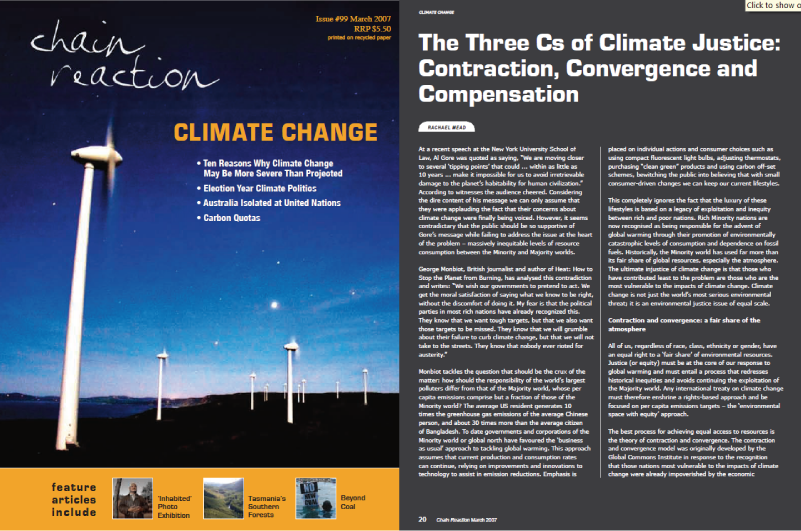
Chain Reaction - FoE Australia
Contraction and convergence: a fair share of the
atmosphere
"All of us, regardless of race, class, ethnicity or gender, have
an equal right to a 'fair share' of environmental resources.
Justice (or equity) must be at the core of our response to
global warming and must entail a process that redresses
historical inequities and avoids continuing the exploitation of
the Majority world. Any international treaty on climate change
must therefore enshrine a rights-based approach and be
focused on per capita emissions targets the 'environmental
space with equity' approach.
The best process for achieving equal access to resources is
the theory of contraction and convergence. The contraction
and convergence model was originally developed by the
Global Commons Institute in response to the recognition
that those nations most vulnerable to the impacts of climate
change were already impoverished by the economic structures and practices of the nations responsible for the
majority of greenhouse gas emissions. The model assumes
that all people have a right to a fair share of carbon resources
within ecological limits. In essence, each individual on the
planet would be allocated an equal share of the sustainable
use of the atmosphere.
Contraction and convergence theory proposes that a global
emissions budget, within ecological limits, be calculated and
reviewed annually."
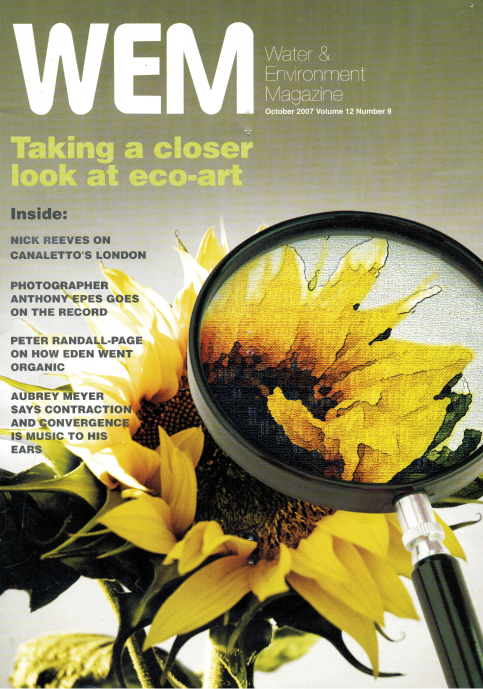
AMEN to Climate Change
"C&C shows how we can take this two-sided problem and turn it into one solution that guides us to deal with both, while ensuring we do enough soon enough to avoid dangerous, runaway climate change.
As there is great acrimony about this double-jeopardy already feeding the politics, I think it helps us to get beyond this by linking the solution to the timeless and universal rationale of music. We can say that correcting the past and present discord of expansion and divergence with the future concord of contraction and convergence, is, quite literally, like an Amen or perfect cadence in music.
In essence musicians have to do two things: one, especially if you are a string player, is to play in-tune; the other, especially if you are playing with others in an orchestra, is to play in-time.
Doing this is what the churches once called just or perfect time management. The hertz (or frequency) value of pitch is embedded in the perfection of the given intervals of the overtone series and this is incontestable and irreducible."
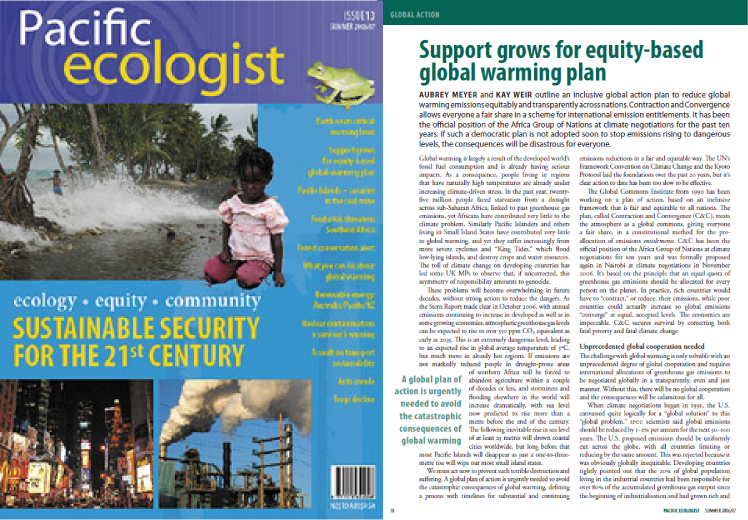
Support grows for equity-based
global warming plan
Aubrey Meyer and Kay Weir outline an inclusive global action plan to reduce global
warming emissions equitably and transparently across nations. Contraction and Convergence
allows everyone a fair share in a scheme for international emission entitlements. It has been
the official position of the Africa Group of Nations at climate negotiations for the past ten
years. If such a democratic plan is not adopted soon to stop emissions rising to dangerous
levels, the consequences will be disastrous for everyone.
Kay Weir - Editor Pacific Ecologist
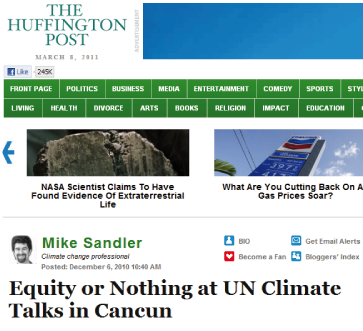
Mike Sandler in the Huffington Post
Equity or Nothing at Cancun Talks
"Contraction & Convergence (C&C) is an example of a simple equity framework. It was devised by Aubrey Meyer of the Global Commons Institute in the UK. C&C starts with a target (say 350 ppm), then says that wealthy countries must reduce emissions (contraction), and then all countries move towards equity in emissions (converge). The first model for C&C focused on countries. Say the average human emits around 5 tons of GHGs per year. Americans emit 20 tons per capita of GHGs each year, but Ethiopians and Haitians emit 1 ton or less per capita. The C&C agreement would set a date in the future when all countries would have equal per capita emissions, and would set up a tradable permit system to implement this transition. Voila! An equity framework."
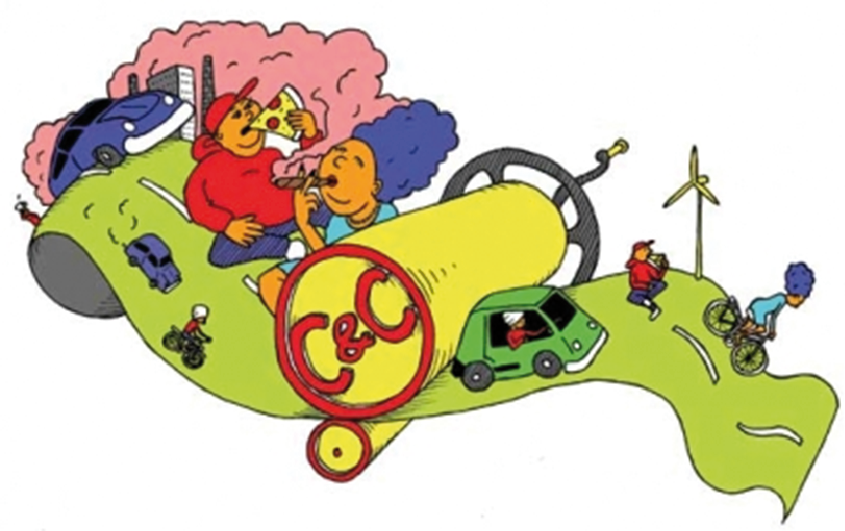
Sly take on C&C from creative Swedish source

1. 'Contraction and Convergence' (C&C) is the science-based global climate-policy framework proposed to the United Nations since 1990 by the Global Commons Institute (GCI).i ii iii iv
2. The objective of safe and stable greenhouse gas concentrations in the atmosphere and the principles of precaution and equity, as already agreed in the 'United Nations Framework Convention of Climate Change' (UNFCCC), provide the formal calculating basis of the C&C framework that proposes: -
A full-term contraction budget for global emissions consistent with stabilising atmospheric concentrations of greenhouse gases (GHGs) at a pre-agreed concentration maximum deemed to be safe, following IPCC WG1 carbon cycle modelling. [GCI regards higher than 450 ppmv CO2 equivalent as 'not-safe'].
The international sharing of this budget as 'entitlements' results from a negotiable rate of linear convergence to equal shares per person globally by an agreed date within the timeline of the full-term contraction/concentration agreement. [GCI suggests [1] the year 2030 or 2040, or around a third of the way into a 100 year budget, for example, for convergence to complete [see point 5 and the images overleaf] and [2] that a population base-year in the C&C schedule is agreed].
Negotiations for this at the UNFCCC should occur principally between regions of the world, leaving negotiations between countries primarily within their respective regions, such as the European Union, the Africa Union, the US, etc.
The inter-regional, inter-national and intra-national tradability of these entitlements in an appropriate currency such as International Energy Backed Currency Units [EBCUs] v should be encouraged.
Scientific understanding of the relationship between an emissions-free economy and concentrations develops, so rates of C&C can evolve under periodic revision.
3. Presently, the global community continues to generate dangerous climate change faster than it organises to avoid it. The international diplomatic challenge is to reverse this. The purpose of C&C is to make this possible. It enables scenarios for safe climate to be calculated and shared by negotiation so that policies and measures can be internationally organised at rates that avoid dangerous global climate change.
4. GHG emissions have so far been closely correlated with economic performance. To date, this growth of economies and emissions has been mostly in the industrialised countries, creating recently a global pattern of increasingly uneconomic expansion and divergence [E&D], environmental imbalance and international insecurity.
5. The C&C answer to this is full-term and constitutional, rather than short-term and stochastic. It addresses inertial argument about 'historic responsibilities' for rising concentrations recognising this as a development opportunity cost to newly industrialising countries. C&C enables an international pre-distribution of these tradable and therefore valuable future entitlements to emit GHGs to result from a rate of convergence that is deliberately accelerated relative to the global rate of contraction agreed [see images].
6. The UK's Royal Commission on Environmental Pollutionvi and the German Advisory Council on Global Changevii both make their climate change recommendations to governments in terms of formal C&C. Numerous individual and institutional statements supporting C&C have been put on the record.viii ix The Africa Group of Nations formally proposed it to the UNFCCC in 1997.x It was agreed in principle at COP-3 Kyoto 1997.xi C&C conforms to the requirements of the Byrd Hagel Resolution of the US Senate of that year xii and the European Parliament passed a resolution in favour of C&C in 1998.xiii
7. This synthesis of C&C can redress the increasingly dangerous trend imbalances of global climate change. Built on global rights, resource conservation and sustainable systems, a stable C&C system is now needed to guide the economy to a safe and equitable future for all. It builds on the gains and promises of the UN Convention and establishes an approach that is compelling enough to galvanise urgent international support and action, with or without the Kyoto Protocol entering into force.
GCI and GDI - accredited to the UNFCCC/IPCC - are comprised of teams of scientists drawn from various institutions in the UK, Italy and elsewhere, working on the science and the sociology of global change.
San Rossore, Tuscany - A New Global Vision
Climate Conference 15th-16th, July 2004
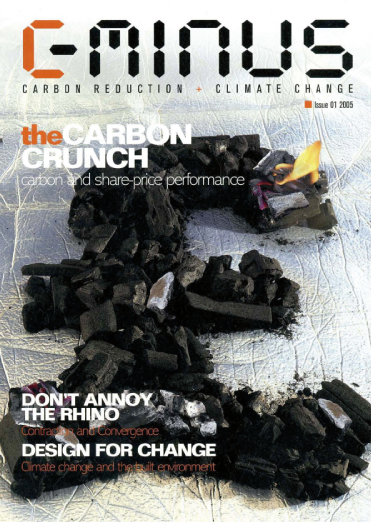
Don't Annoy the Rhino
"There is a tale about an angry Rhino and the
Salisbury-Bulawayo Express.
In what was old Rhodesia, a steam train used to
go daily between those towns along a single track.
But there was trouble. The train track ran through rhino
territory and as time went by the cranky old lead
rhino took umbrage about the train and its
route and planned a counter-strike. One day, as the
train chugged south at 70 miles an hour, the rhino
mounted the track and charged north. The resulting
train-smash derailed the train and killed the rhino.
A comparable kamikaze situation is developing with global dimate change. With greenhouse gas
emissions still accelerating upwards, we are now going down the tracks towards the oncoming
angry rhino of dangerous climate change at a
rate that threatens chaotic impacts and challenges
species survival. In more technical language, despite the heroic
arrangements in favour of the "Kyoto Protocol', we continue globally to cause climate change
much faster than our response to avoid it. So the
key question is, what does it really lake to avoid
this chaos?
The answer is 'Contraction and Convergence'
(C&C). Wlth appropriate haste, fossil fuel
emissions must contract globally while the international shares in this converge."
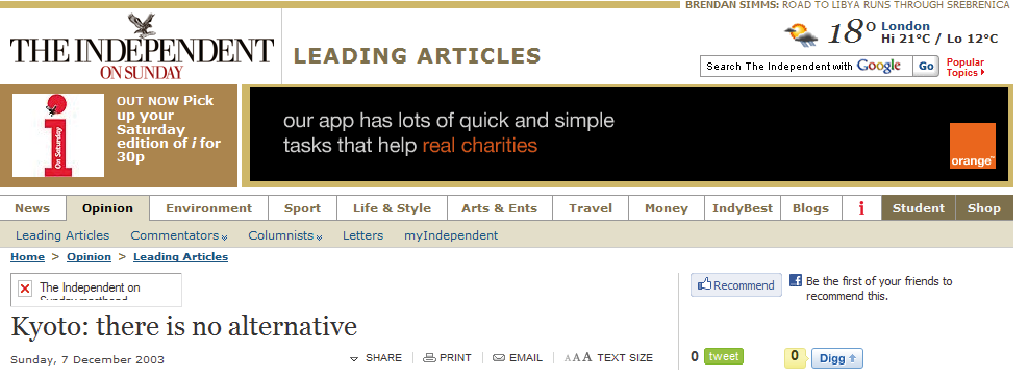
The future of the planet now rests in the hands of three people: President George Bush, President Vladimir Putin - and the unlikely figure of one Aubrey Meyer, a former concert violinist from east London. President Bush has set out to kill the Kyoto Protocol. Despite growing support in the US for addressing climate change, he has spared no effort in stopping it coming into effect. He is putting the screws on President Putin. Under the protocol's rules, it now only needs Russia's ratification to come into force. The signals from Moscow are mixed, but Putin is thought to be waiting to see whether the US or the European governments, who support Kyoto, will come up with the best price.
The future of the planet now rests in the hands of three people: President George Bush, President Vladimir Putin - and the unlikely figure of one Aubrey Meyer, a former concert violinist from east London. President Bush has set out to kill the Kyoto Protocol. Despite growing support in the US for addressing climate change, he has spared no effort in stopping it coming into effect. He is putting the screws on President Putin. Under the protocol's rules, it now only needs Russia's ratification to come into force. The signals from Moscow are mixed, but Putin is thought to be waiting to see whether the US or the European governments, who support Kyoto, will come up with the best price.
And Mr Meyer? He is the still relatively unknown originator of a body that is fast becoming the leading contender in the fight against global warming, after Kyoto. To that end, he has set up the Global Commons Institute. Michael Meacher, the former Environment minister, endorses the plan - dubbed "contraction and convergence" - on page 22. The Royal Commission on Environmental Pollution, the World Council of Churches, and African governments have all adopted it. Under the plan, every person on the planet would have the right to emit the same amount of carbon dioxide, which is the main cause of global warming. Each nation would be set quotas, adding up to a figure the world's climate could tolerate. They would be expected to meet them, say by 2050, and could buy and sell parts of them.
Kyoto must first be brought into force: there is no alternative. Then nations should start negotiating bigger cuts in pollution on this equitable basis - worked out in an unprepossessing London flat.
Kyoto: there is no alternative
Leader in the Sunday Independent, 7th December 2003
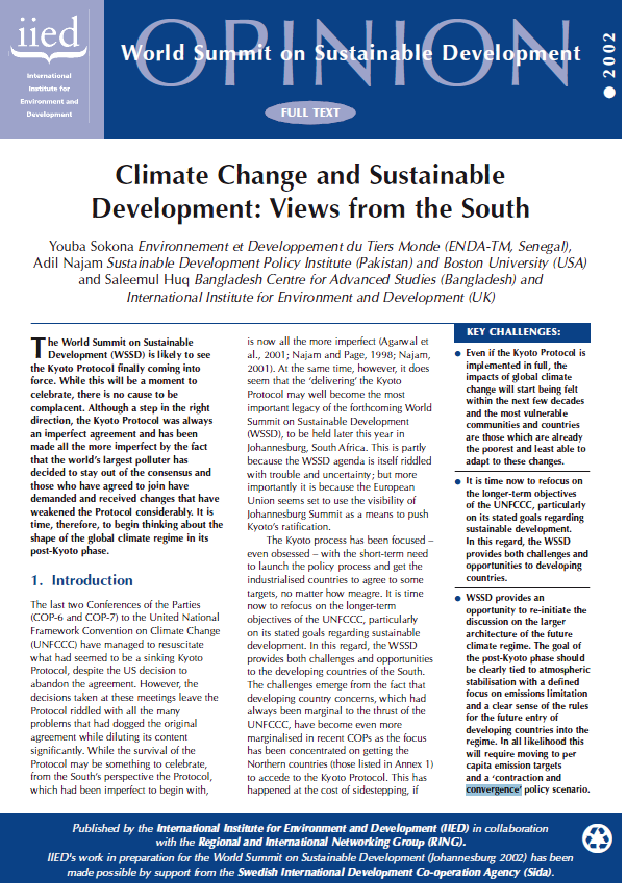
WSSD provides an opportunity to re-initiate the discussion on the larger
architecture of the future climate regime. The goal of
the post-Kyoto phase should
be clearly tied to atmospheric
stabilisation with a defined
focus on emissions limitation
and a clear sense of the rules
for the future entry of
developing countries into the
regime. In all likelihood this
will require moving to per
capita emission targets
and a 'contraction and
convergence' policy scenario.
Climate Change and Sustainable Development: Views from the South -
Youba Sokona Environnement et Developpement du Tiers Monde (ENDA-TM, Senegal), Adil Najam Sustainable Development Policy Institute (Pakistan) and Boston University (USA) and Saleemul Huq Bangladesh Centre for Advanced Studies (Bangladesh) and IIED UK
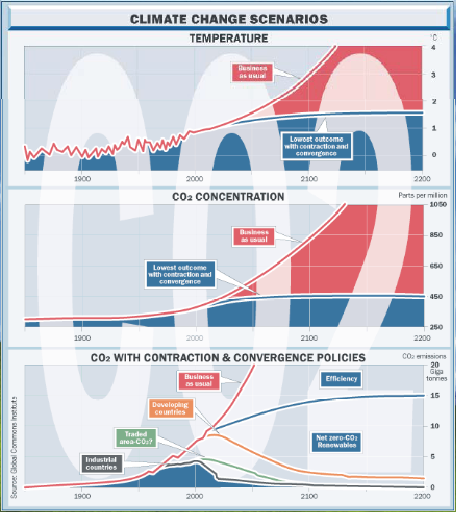
Consider the ambitious target for reducing carbon emissions suggested two years ago by Britain's Royal Commission on Environmental Pollution. Its proposal was to reduce emissions by 60 per cent by 2050, possibly through an international agreement called Contraction and Convergence, which has been much discussed in Johannesburg. This would give every country a quota for carbon emissions, based on its population and would allow countries to trade these emission rights. This would gradually reduce worldwide carbon emission and encourage the development of more efficient technologies. In the meantime, it would ensure a flow of funds from rich countries to poor ones, which, because of their lower levels of car ownership and industrialisation, would have surplus emission rights.
Capitalism is the best way to save the planet
Anatole Kaletsky in the Times
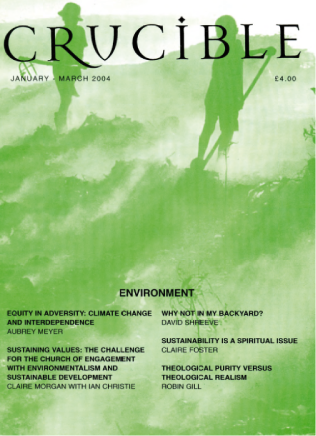
The CRUCIBLE editorial observes; - "The poor, less industrial countries are largely those
that will suffer the consequences of global warming:
worsening and greater frequency of storms, floods,
desertification, crop failures, famines, eco-system
collapse, species migrations and extinctions, disease
vectors, refugees, social tensions, economic failures
and large-scale political conflicts . . . [with] the rising
of sea levels through warming of the waters . . . [to]
cap all of these tragedies. [Aubrey Meyer's article
"Equity in Adversity"] compares the global apartheid,
with the few offering a legacy of poverty - in the
widest sense - to the many, with the political apartheid
with which he grew up in South Africa. In the
end, the only solution that ensured a future of any
description was one that involved every citizen of
the country. The visionary genius and transcendental
forgiveness of Nelson Mandela made that possible.
Similarly, the solution to global warming has to be
planet-wide, or it will not work. Contraction and Convergence
answers this call to unity.
Equity in Adversity - The Crucible
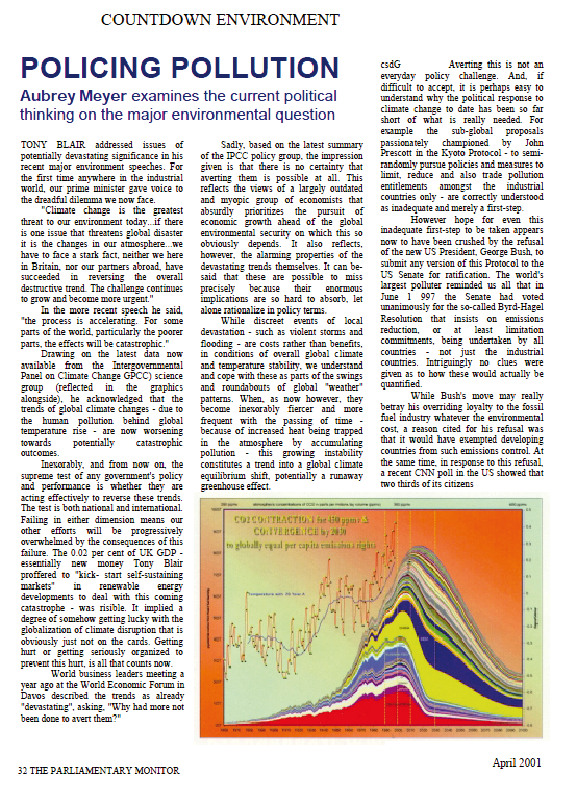
Averting devastating global climate change is going to he like fighting a hundred years' war. Unless the total
notion and process of governance is reconfigured to the over-riding purpose of winning this war, Mr. Blair's strong words will gradually become a selffulfilling prophecy.
Aubrey Meyer is the Director of the Global Commons Institute and author of Contraction and Convergence - the Global Solution to Climate Change. Graphics are reproduced with the kind Permission of Green Books.
Policing Pollution - Parliamentary Monitor
Aubrey Meyer
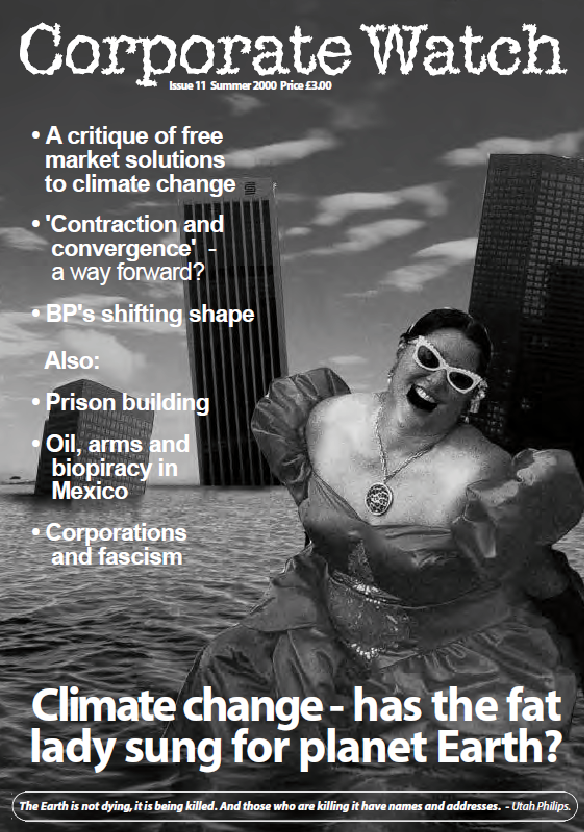
One framework attempting to create
political space to tackle climate change
is "Contraction and Convergence"
outlined by Aubrey Meyer on page 8. This framework uses a solid scientific grounding to look at more equitable distribution and to allow for the atmosphere to be viewed as a common resource for all life on the planet. Contraction and convergence avoids ideology yet keeps at its heart the alleviation of oppression.
Contraction and convergence takes a pragmatic stance of starting from the world as it currently operates, yet refers to the overall framework of equity. It gives rise to a number of questions:
If contraction and convergence were to be seriously considered by the powers that be, would this mean being watered down to become meaningless?
How radical a context does this framework present for emissions trading and the complexities which this throws up?
What conclusions do we draw from the recognition, forced upon us by climate change, that we are part of an ecosystem?
Corporate Watch
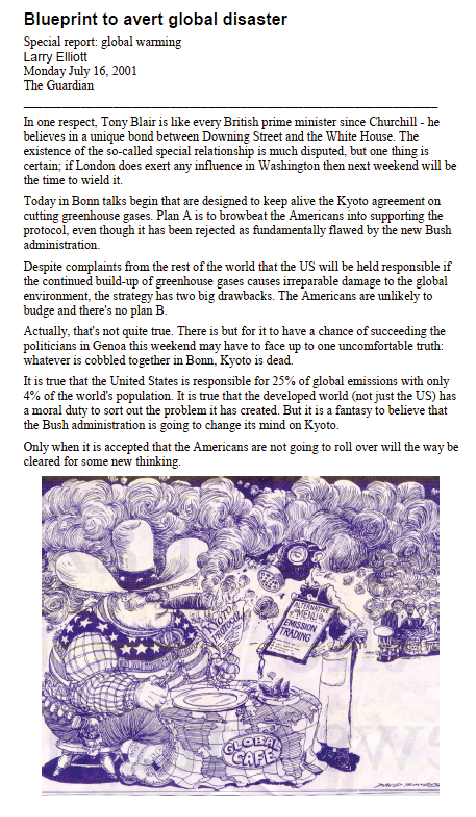
The US government has never sought to deny that climate change is a problem,
simply that Kyoto is the wrong way of dealing with it. In particular, Washington has
argued that a global problem needs a global solution, which means including countries
in the developing world, too.
Fortunately, a blueprint exists which not only answers the US objections to Kyoto but
offers a coherent strategy for cutting greenhouse gases.
The plan, known as contraction and convergence, is simpler than Kyoto's Byzantine complexity, offers a way of getting the Americans to come on board, has built-in flexibility, and a market mechanism built into it. Although C&C was the brainchild of green activists, the irony is that it would be good for business. It is hardly surprising that it is winning new supporters all the time, including Michael Meacher, the environment minister.
Blueprint to avert global disaster
Larry Elliott the Guardian

The Rt Revd John Oliver, the
Bishop of Hereford, and the Church of
England's environmental spokesman in
the House of Lords, began a presentation
saying his aim was to convert the
Congress to support the idea of
"contraction and convergence". This
theory already has considerable support
but he was frustrated that so few people
know about it, despite the fact that it
could be much more effective than the
Kyoto agreement. Contraction involves
the world agreeing to contract the
amount of emissions over time to a
specified amount. Convergence involves
every country being given a certain
number of permits to pollute, according
to population size. Countries with spare
permits to pollute can sell them to other,
more polluting countries through
emissions trading. The Bishop
emphasised the need for action now, as
insurers calculate that by 2065 the cost of
environmental damage will exceed the
world's GDP.
Anglican World
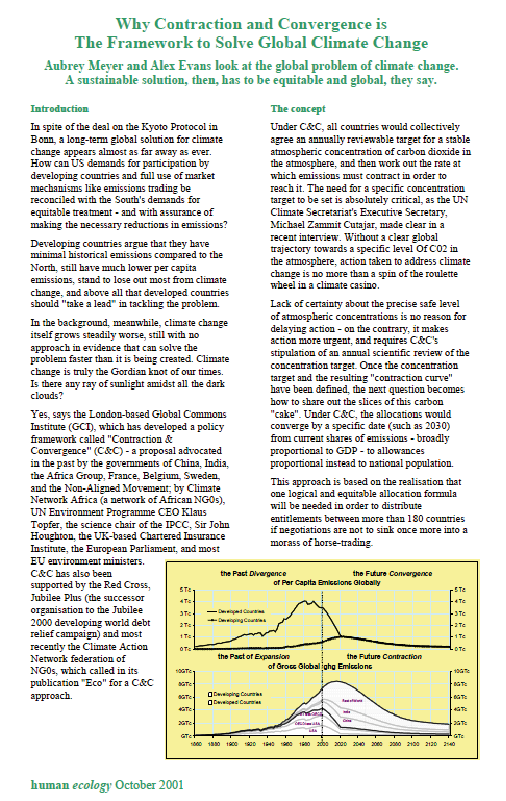
Under C&C, all countries would collectively agree an annually reviewable target for a stable atmospheric concentration of carbon dioxide in the atmosphere, and then work out the rate at which emissions must contract in order to reach it. The need for a specific concentration target to be set is absolutely critical, as the UN Climate Secretariat's Executive Secretary, Michael Zammit Cutajar, made clear in a recent interview. Without a clear global trajectory towards a specific level Of C02 in the atmosphere, action taken to address climate change is no more than a spin of the roulette wheel in a climate casino. Lack of certainty about the precise safe level of atmospheric concentrations is no reason for delaying action - on the contrary, it makes action more urgent, and requires C&C's stipulation of an annual scientific review of the concentration target. Once the concentration target and the resulting "contraction curve" have been defined, the next question becomes how to share out the slices of this carbon "cake". Under C&C, the allocations would converge by a specific date (such as 2030) from current shares of emissions - broadly proportional to GDP - to allowances proportional instead to national population. This approach is based on the realisation that one logical and equitable allocation formula will be needed in order to distribute entitlements between more than 180 countries if negotiations are not to sink once more into a morass of horse-trading. human ecology October 2001
Why Contraction and Convergence is
The Framework to Solve Global Climate Change
Aubrey Meyer and Alex Evans look at the global problem of climate change
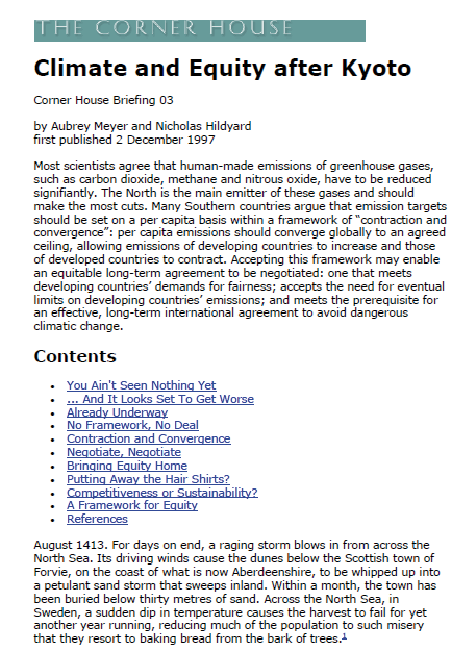
"Most scientists agree that human-made emissions of greenhouse gases, such as carbon dioxide, methane and nitrous oxide, have to be reduced signifiantly. The North is the main emitter of these gases and should make the most cuts. Many Southern countries argue that emission targets should be set on a per capita basis within a framework of "contraction and convergence": per capita emissions should converge globally to an agreed ceiling, allowing emissions of developing countries to increase and those of developed countries to contract. Accepting this framework may enable an equitable long-term agreement to be negotiated: one that meets developing countries' demands for fairness; accepts the need for eventual limits on developing countries' emissions; and meets the prerequisite for an effective, long-term international agreement to avoid dangerous climatic change."
Climate&_Equity_after_Kyoto
Corner House - Hildyard Meyer
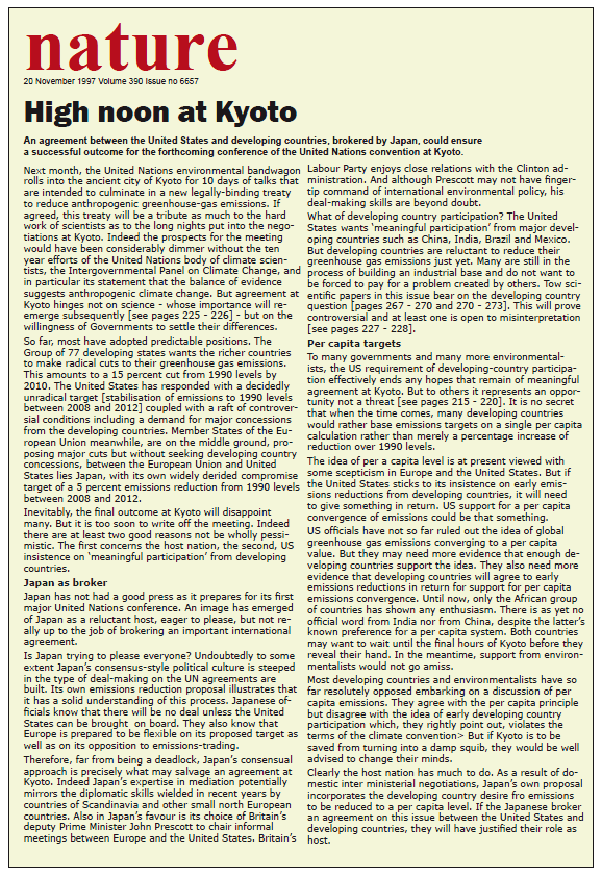
Most developing countries and environmentalists have so far resolutely opposed embarking on a discussion of per capita emissions. They agree with the per capita principle but disagree with the idea of early developing country participation which, they rightly point out, violates the terms of the climate convention. But if Kyoto is to be saved from turning into a damp squib, they would be well advised to change their minds.
Editorial in NATURE Magazine November 1997
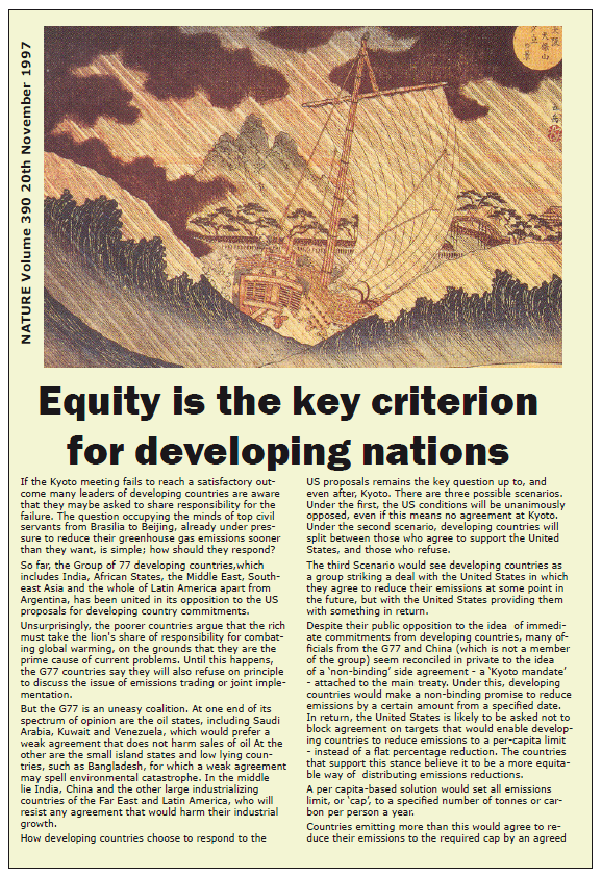
Per capita solution?
Those who have been promoting the idea that the world's emissions could converge on a single, per-capita figure include the London-based environmentalist lobby group the Global Commons lnstitute. Aubrey Meyer, GCI's director, says that if a per capita strategy were to be followed, global concentrations of carbon dioxide could stabilize by 2030 at a level of 450 parts per million by volume of the atmosphere.
Equity is the key criterion for developing countries
NATURE Magazine November 1997

Our-Planet-Magazine [Hanmbock Meyer]
"High and low per capita
carbon emissions are
a proxy for wealth
and poverty both within and
between nations. One third of
the world's people enjoy 94
per cent of the global dollar
income and account for 90 per
cent of the greenhouse gases
so far emitted throughout
history; the other two thirds
share just 6 per cent of this
income and 10 per cent of the
emissions."
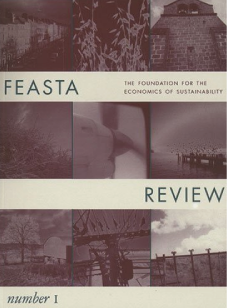
FEASTA Review Chapter
"If humanity's reaction to the threat of global warming is not fast and effective, we
might as well not bother to respond at all because the only thing slow and grudging
actions would achieve would be to delay the onset of whatever is to happen by a
few years. The choice we face is therefore between making determined, drastic
changes now, or doing nothing."
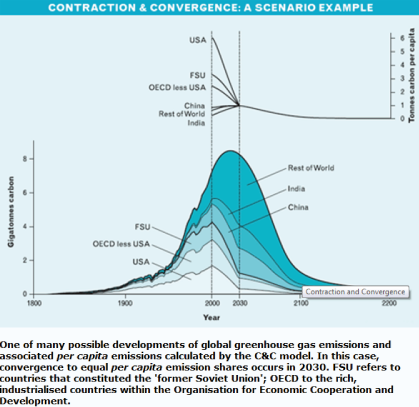
Tiempo Climate Newswatch [Hanmbock Meyer]
"Aubrey Meyer and Raphaël Hanmbock describe Contraction and Convergence, a flexible and equitable response to climate change after the Kyoto Protocol. Aubrey Meyer, a musician by training, co-founded the Global Commons Institute in London in 1990. Since then, he has contributed to the Intergovernmental Panel on Climate Change and campaigned to win acceptance of Contraction and Convergence. Raphaël Hanmbock is Executive Director of ACAN (Association des Clubs des Amis de la Nature) and Coordinator of the Climate Action Network in the Cameroon."
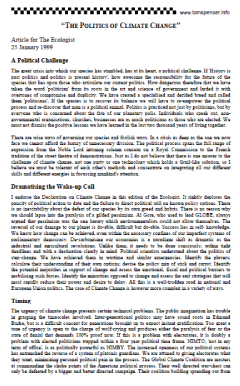
The Politics of Climate Change [Spencer 1999]
"As a small group of environmentally-committed parliamentarians, Global Legislators Organisation for
a Balanced Environment (GLOBE) recognises the scale of the political task that faces us all. However
GLOBE believes that there are ways to avoid being overcome by millennial pessimism. The group has
sought to find a common language and an acceptable timeframe in which to conduct these political
debates. GLOBE has adopted and promoted the contraction and convergence analysis developed by
the Global Commons Institute, which aims to determine the amount by which global carbon emissions
must be reduced and how to distribute the burden equitably. The analysis is an elegant representation of
the challenge that faces humanity and the solution that lies within our grasp. It is however merely a
model to frame diplomatic and political activity. It is not an answer, a mandate or a magic totem. It
illustrates the shared nature of humanity's predicament and points towards a conclusion that maximises
both efficiency and equity. It provokes ideas to enable political elites to escape from the four-year time
trap. It has visual impact, and it powerfully communicates the nature of the choices to the world's
electorates. It seeks to use instruments such as markets to correct the malfunctions that we
unknowingly stumbled into in the adolescence of our industrial age, all within an achievable political
timescale. It has neither winners nor losers. It points to those habits that will destroy us, as well as to
those survival instincts that can save us."

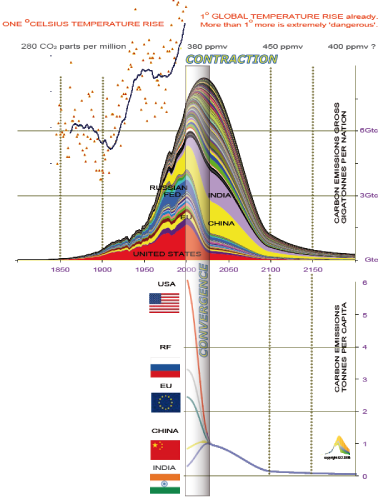
A Musician's YANTRA
"Having sought the right memorable sound bites, Meyer has now turned his attention to the visual with a colour graphic of memorable outline but densely loaded with information. The bottom axis is time, from the pre-industrial 1860s to the post-industrial (or post-deluge) 2090s, a century hence. The upright axis is gigatonnes of carbon from fossil fuel burning. Within the axis framework is a thin global surface temperature line slowly trending upward with a slight dip in the 1920s, and a startling graph of the quantity of emissions for each century over time, both real in the past, and to be hoped for in a better future of 'contraction and convergence'. There is a giant wave peaking after 2010 and beginning to turn down by 2030.
The message in words and pictures is both clear and simple, but also densely loaded with implications and, in the case of the graphic, with data sets as well. So powerful is the graphic presentation that it has been called a 'yantra', a term which Buddhists reserve for the most powerful provokers of thought and reflection among the earthly minds.
Since Meyer has proved to be no mean marketing expert, he may think of finding a sponsor to make it into up-market dinner tables thus providing a basis for conservation among the influential. What is needed is someone serious, rich and fashionable to launch it on a social occasion. May be Bill Gates could leaven the launch of his softwares with something of charitable worth based on Meyer's yantra."
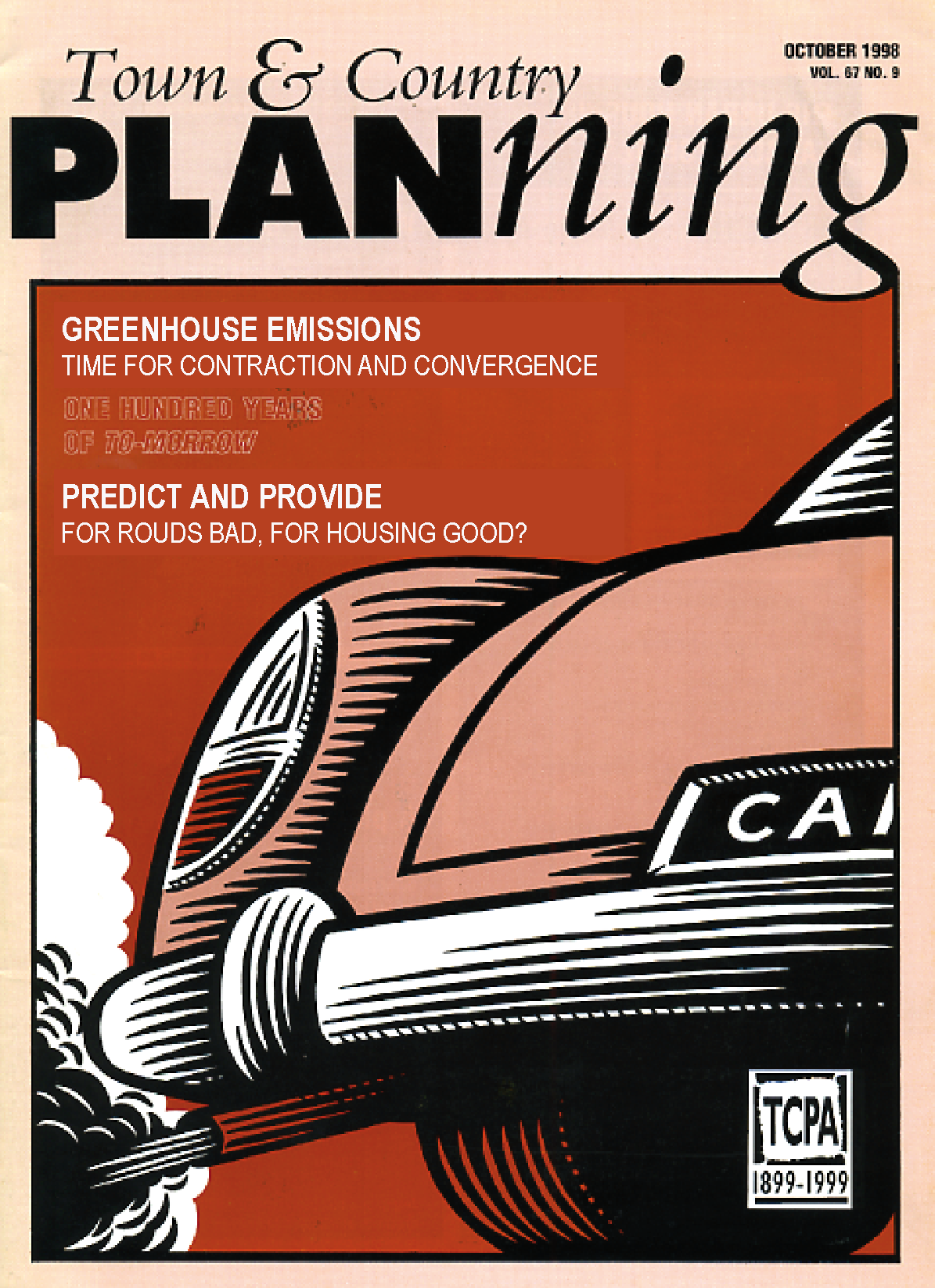
Time for Contraction and Convergence
Town and Country Planning - October 1998
Edited By Mayer Hillman
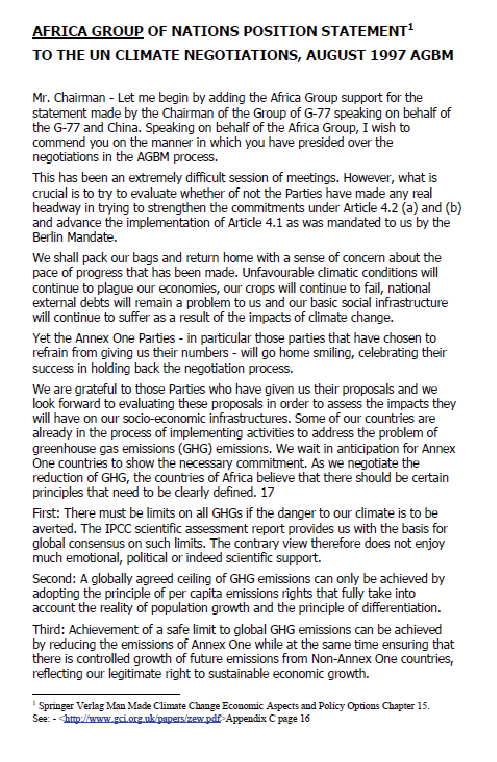
To create a sustainable basis on which to achieve 'Equity and Survival', GCI developed the 'Contraction and Convergence' (C&C) model of future emissions. In 1995 the model was introduced by the Indian Government [3] and it was subsequently adopted and tabled by the Africa Group of Nations in August 1997

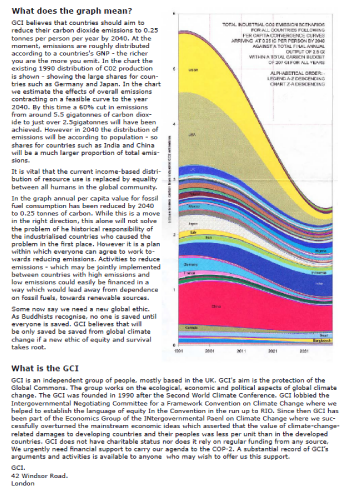
Tough But True - First images of C&C published before COP-2

"Who Says that Life is Cheap?" Guardian November 1995
"It was a triumph for Aubrey; but why has everyone been happy to leave him and his handful of friends to fight what is patently absurd. What was the British government thinking of when it generously grant aided Professor Pearce's IPCC work. Why was his team so determined to produce figures that show that little need be done about warming that they refused to accept even the possibility of much worse damage happening? Was it that they couldn't see that at least as much growth could be generated building a new type of economy as it can by tinkering with the old?"
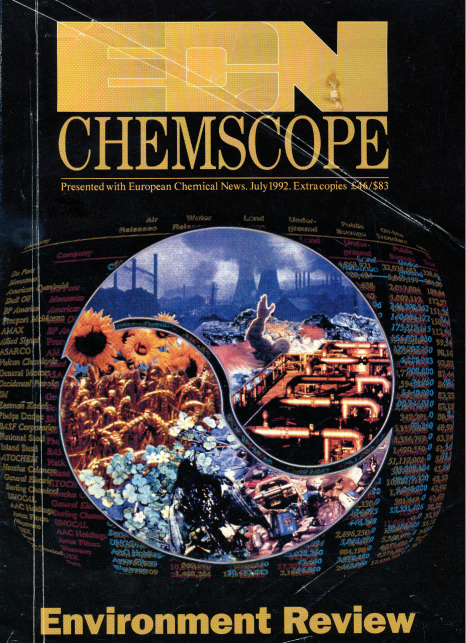
Green Rights for All - ChemScope 1992
Can the opposing demands of North and South ever be
reconciled with the future health of the planet?
ECN asked
environmentalist Aubrey Meyer to give his view of the
discussions at UNCED.
.

